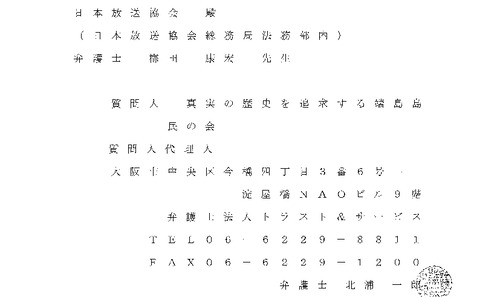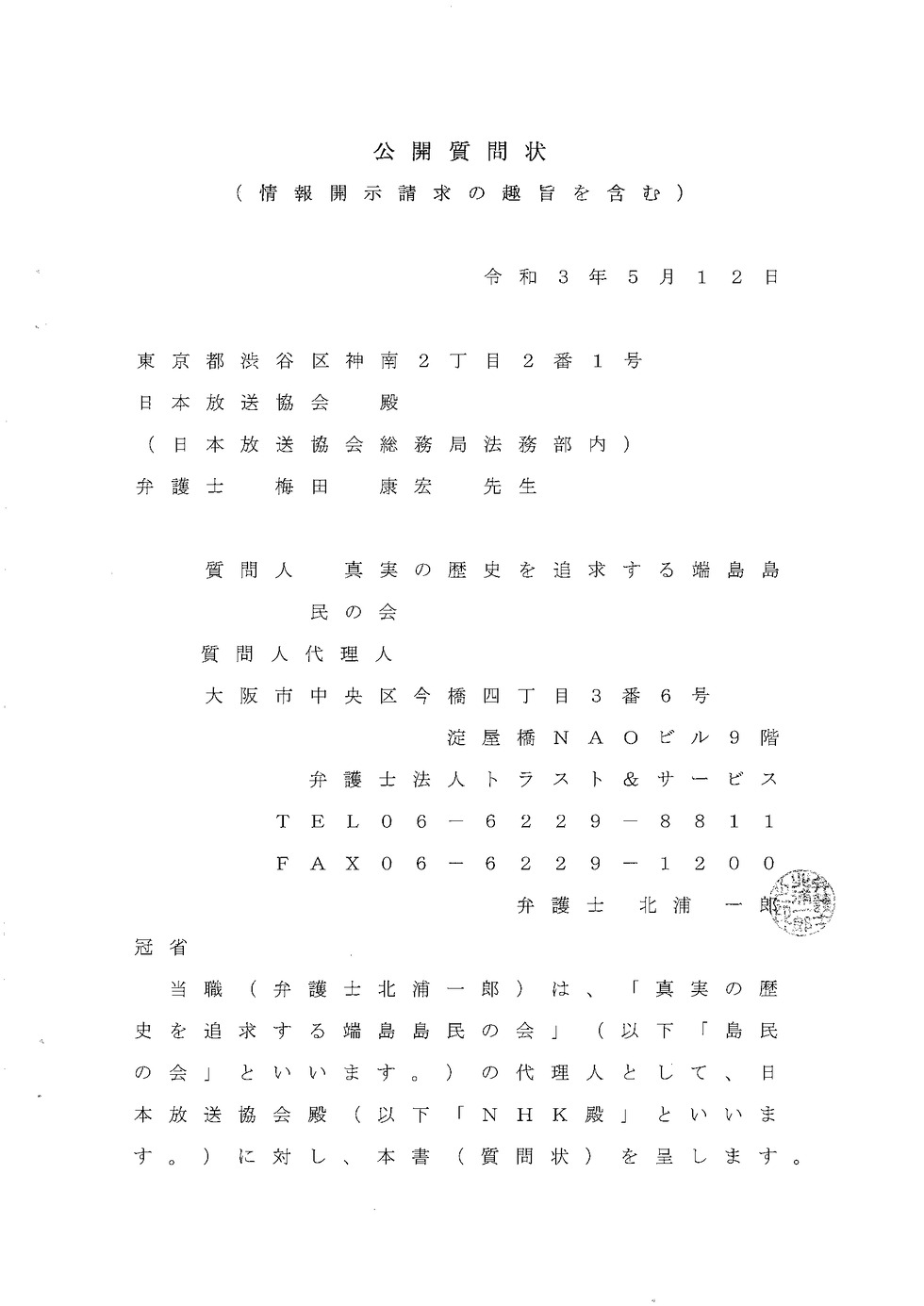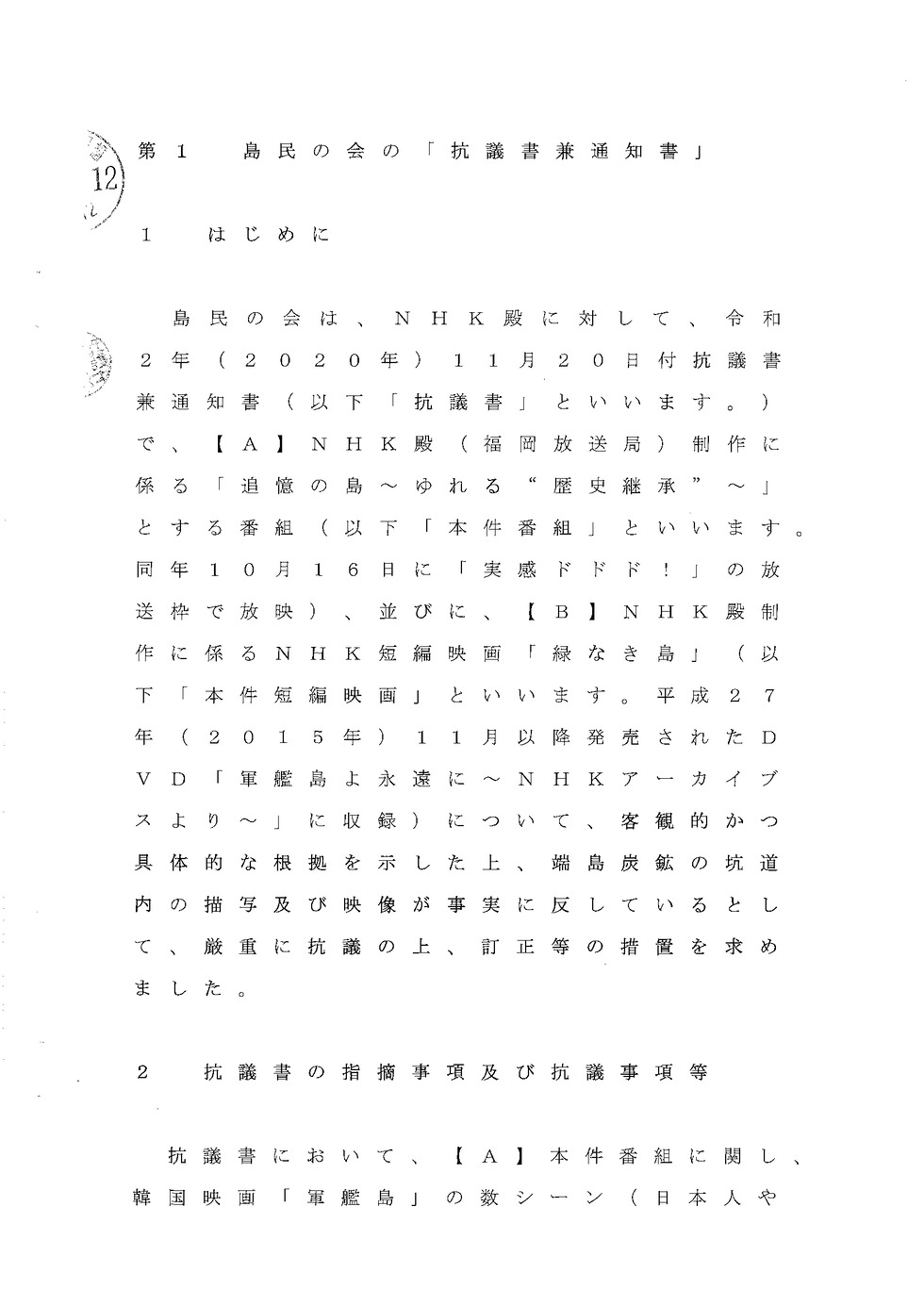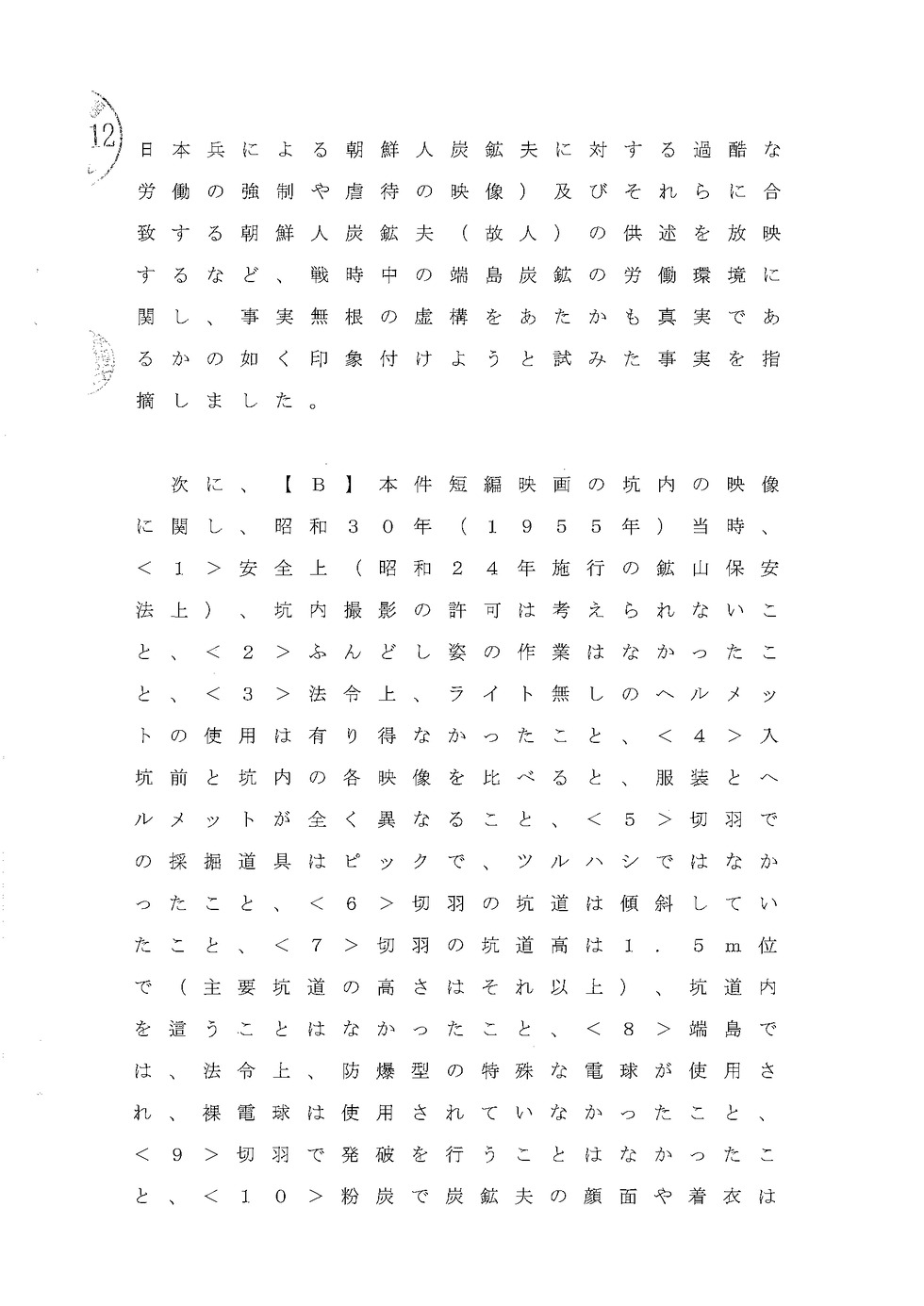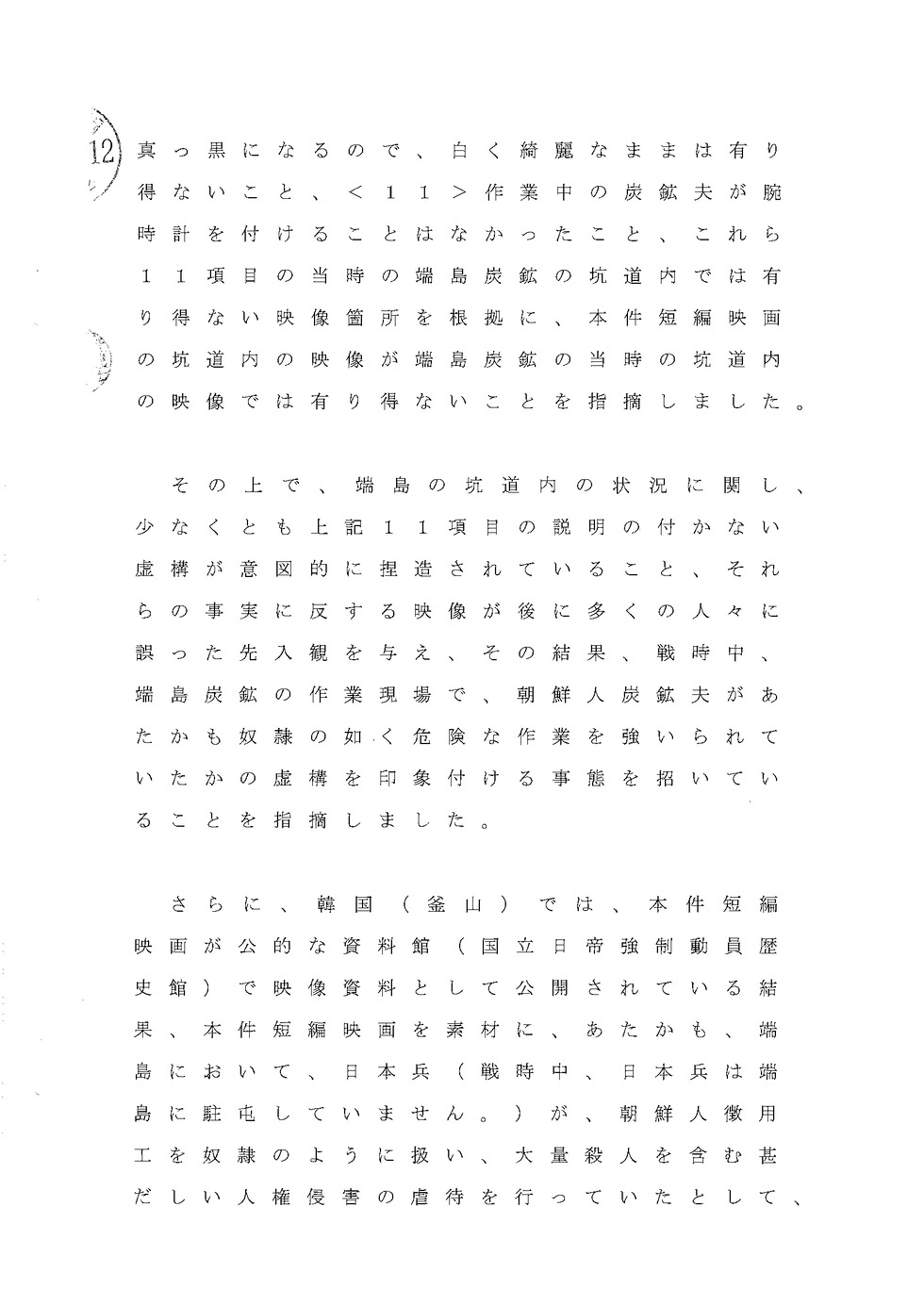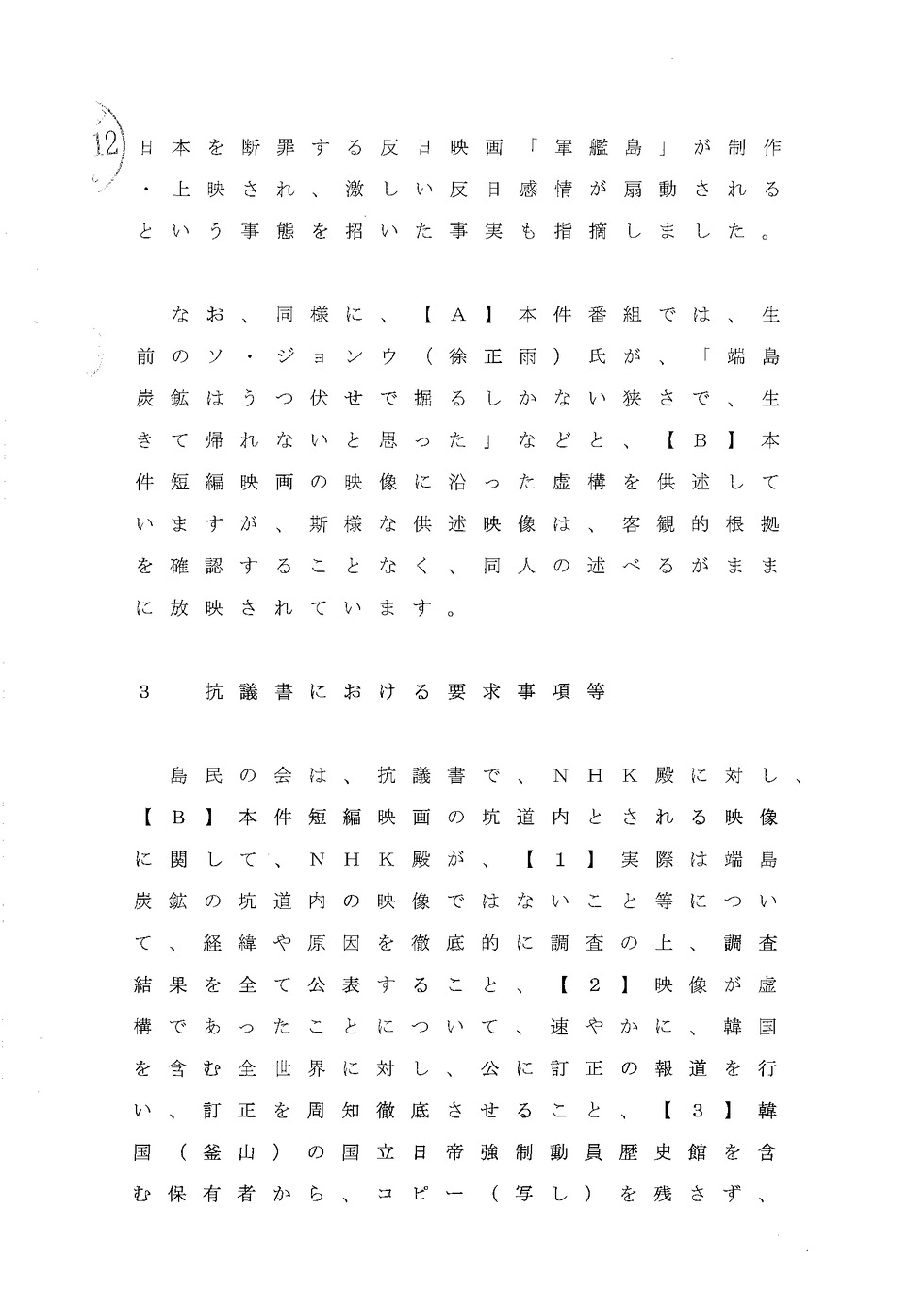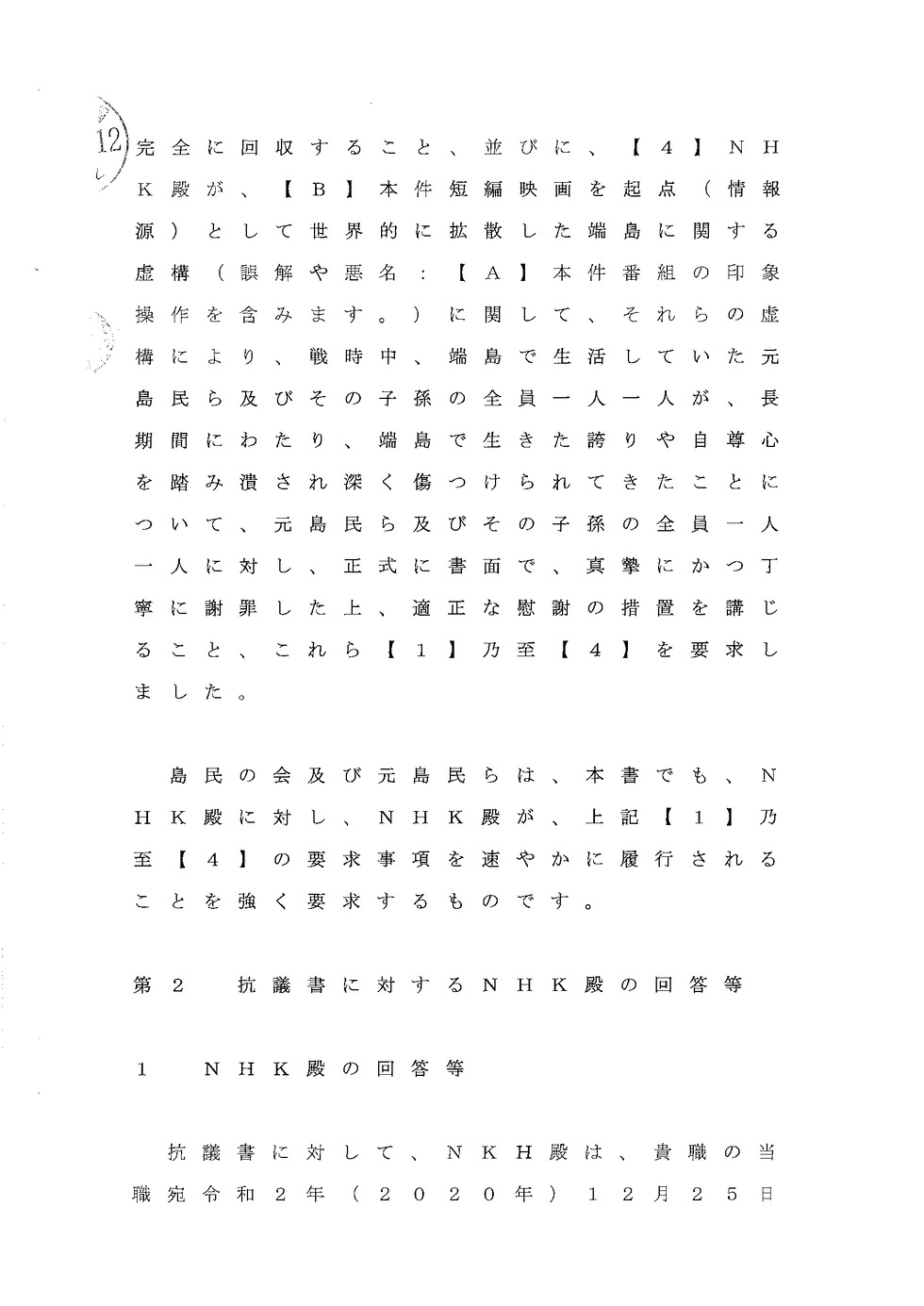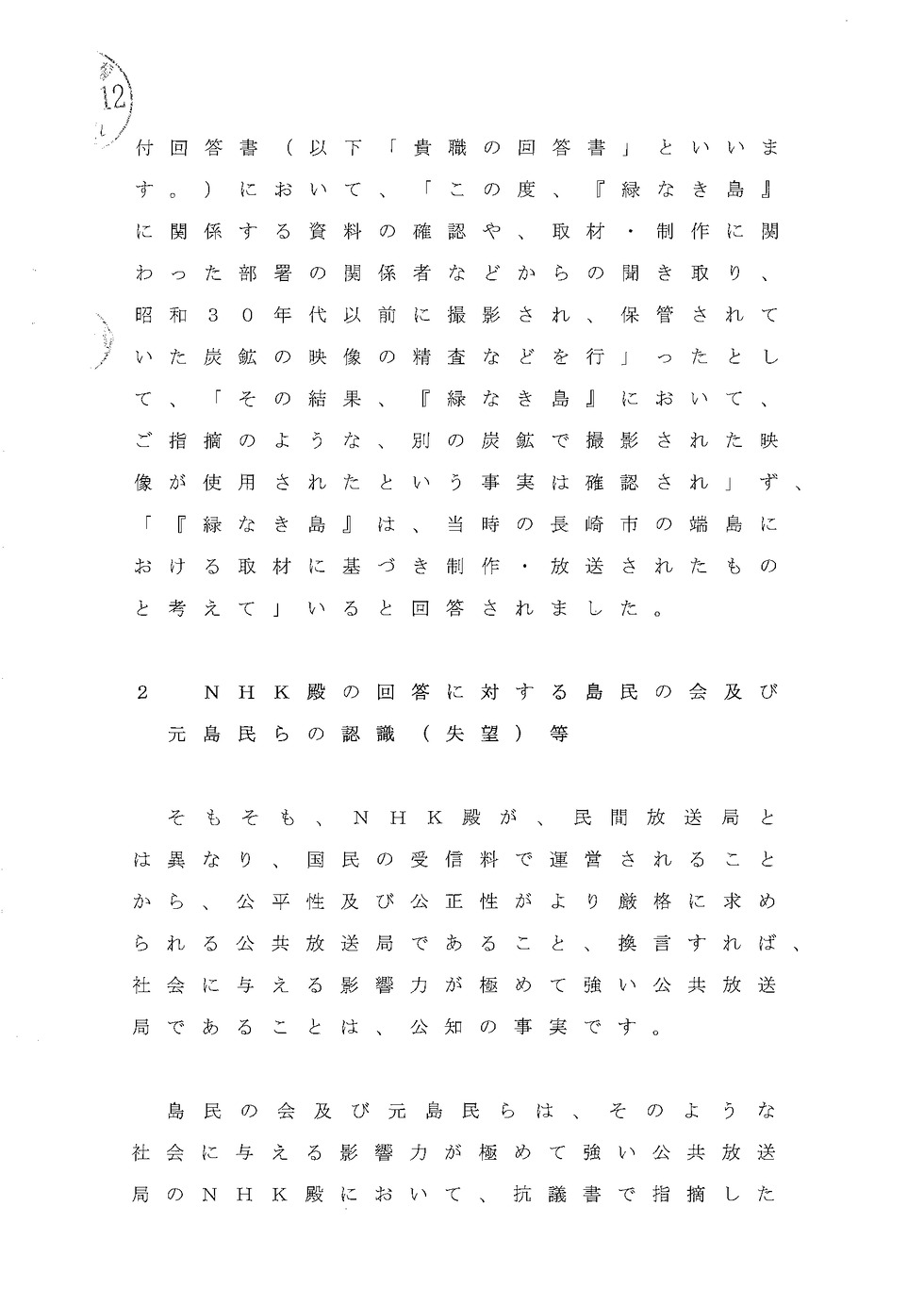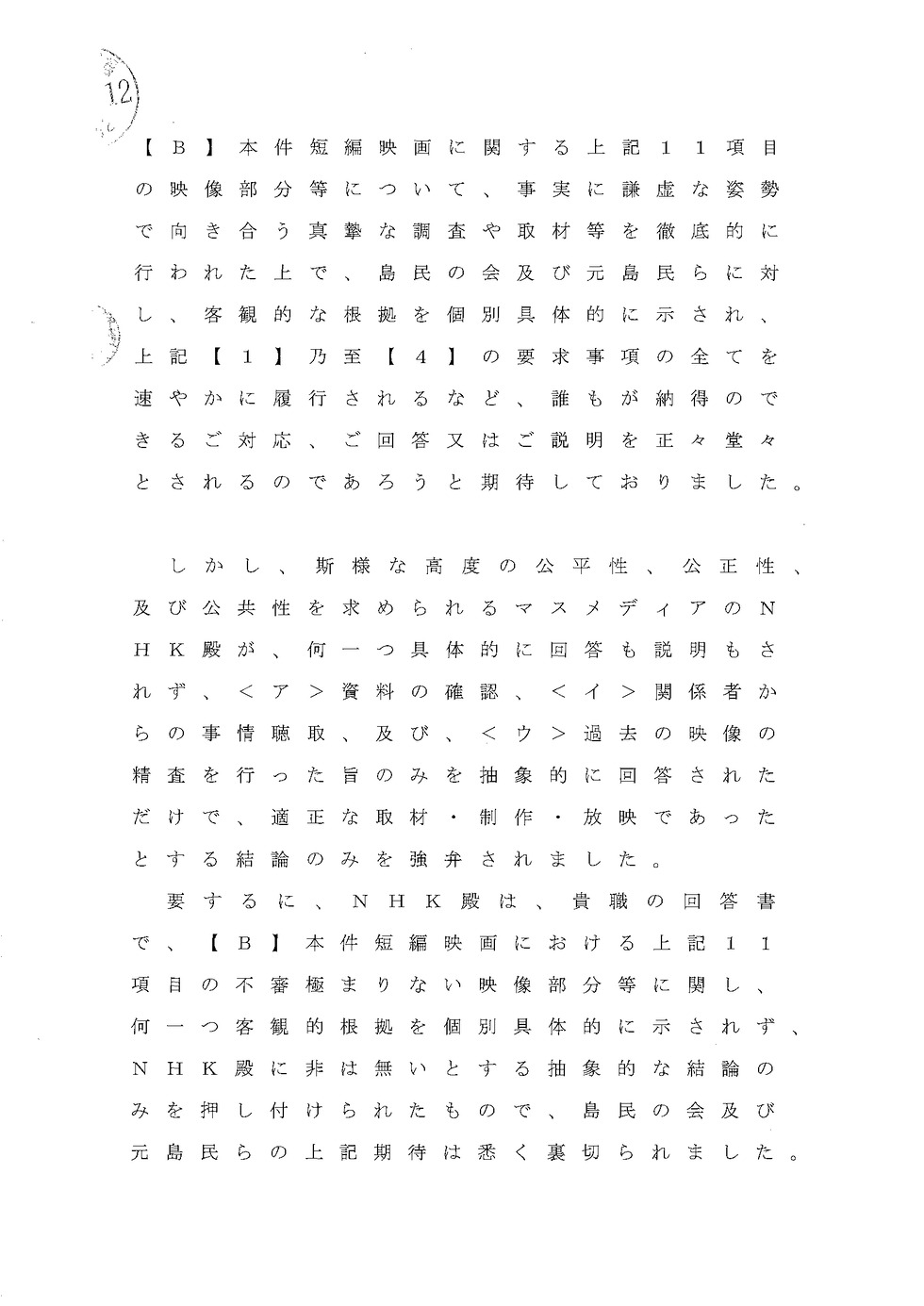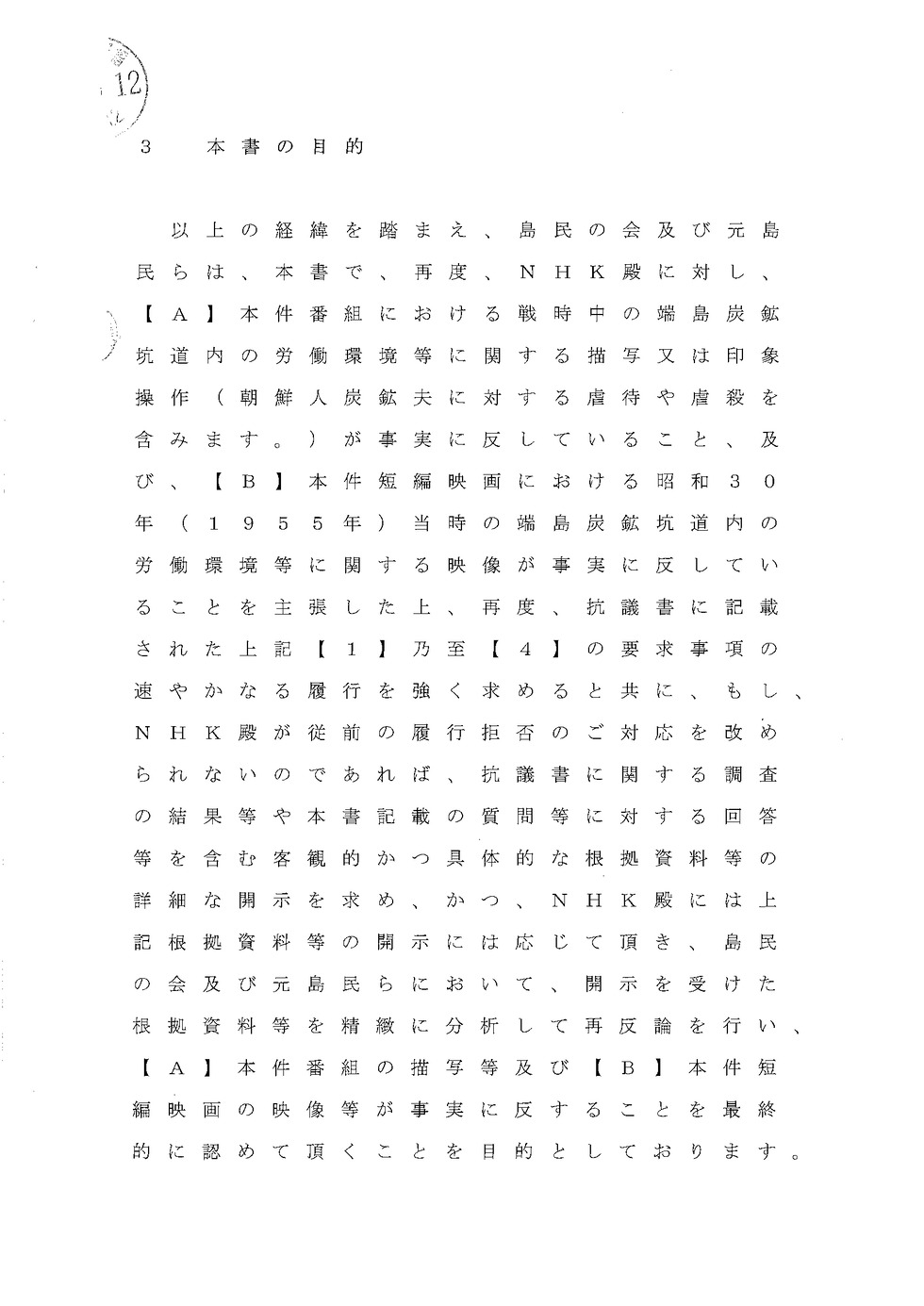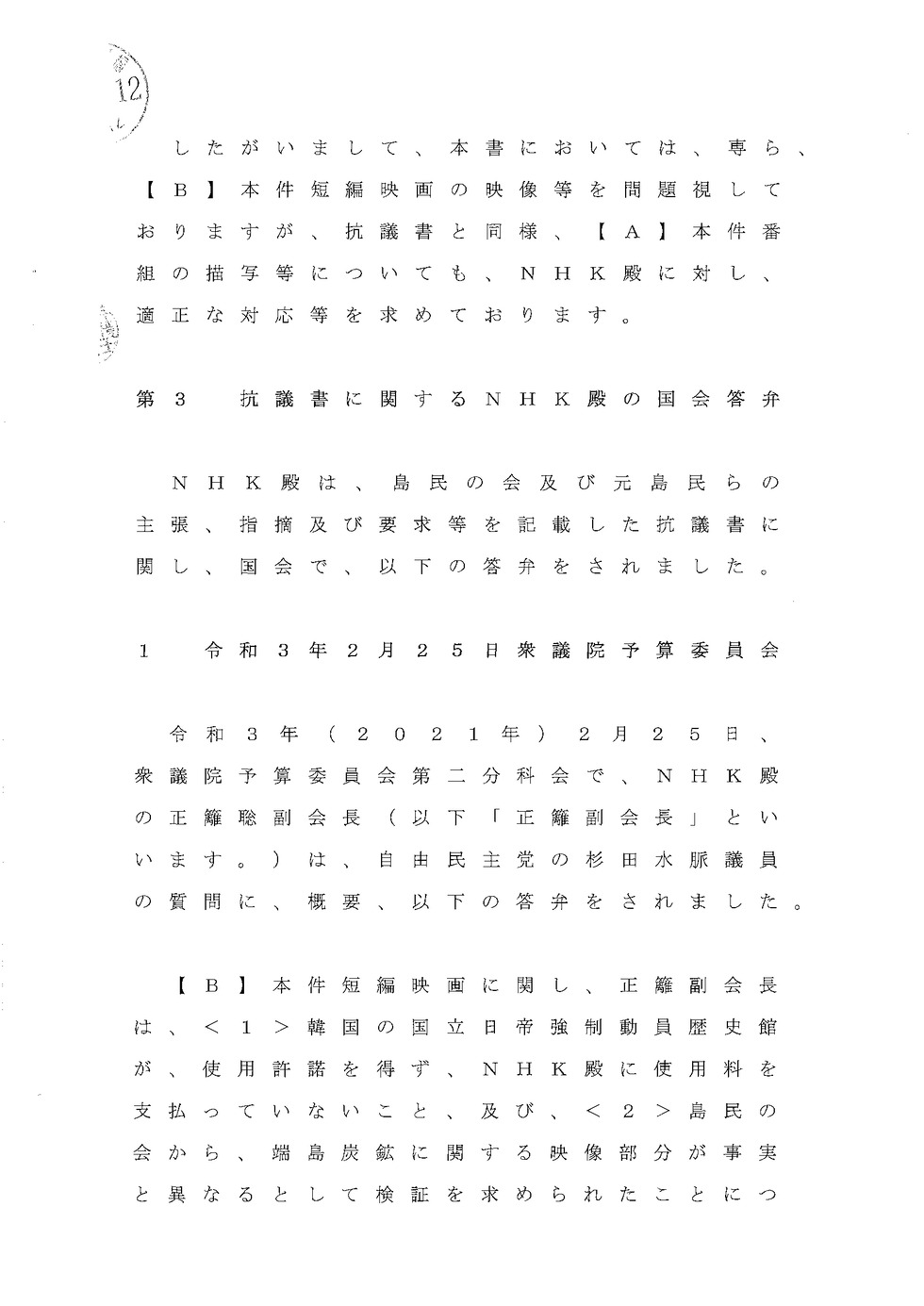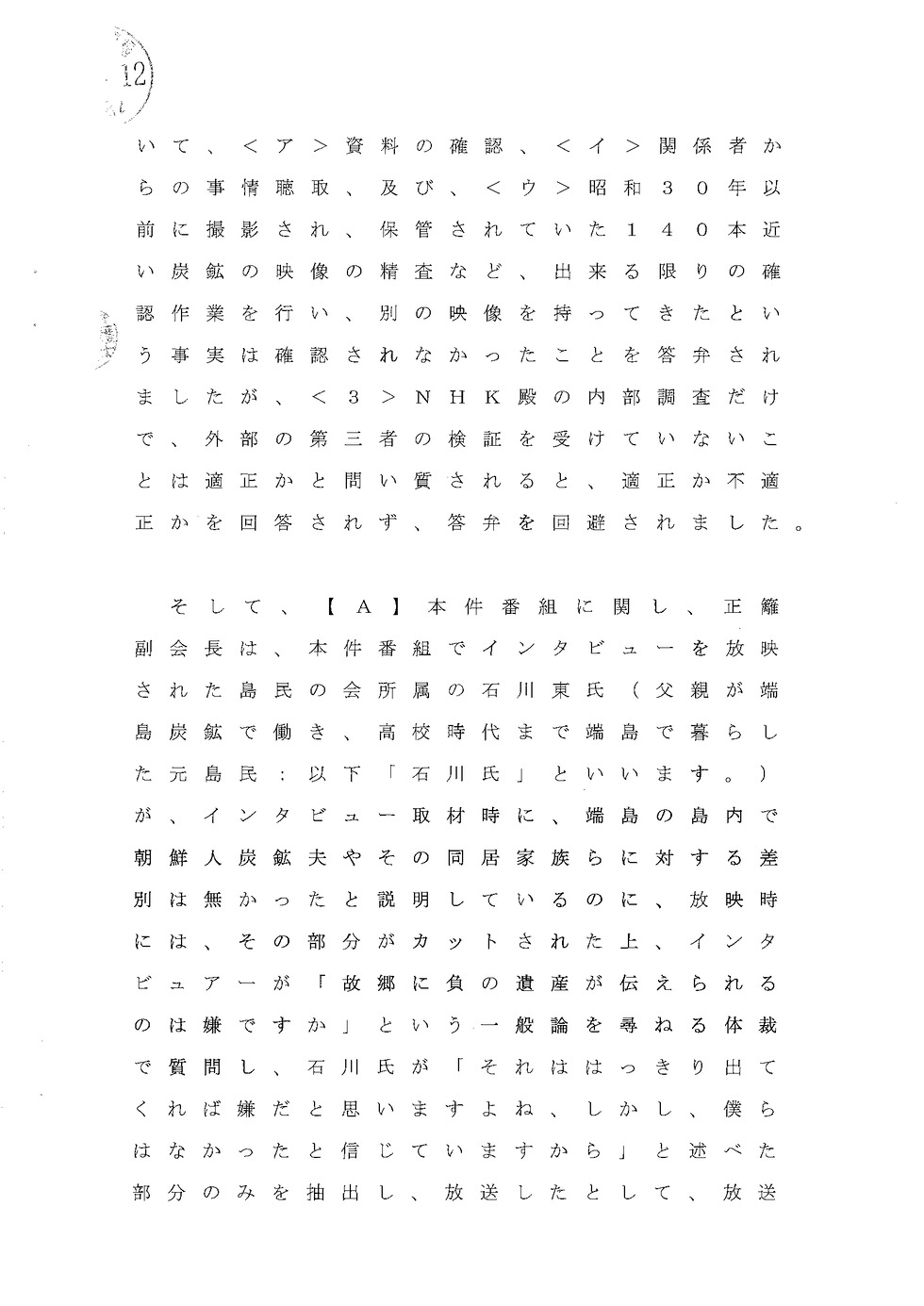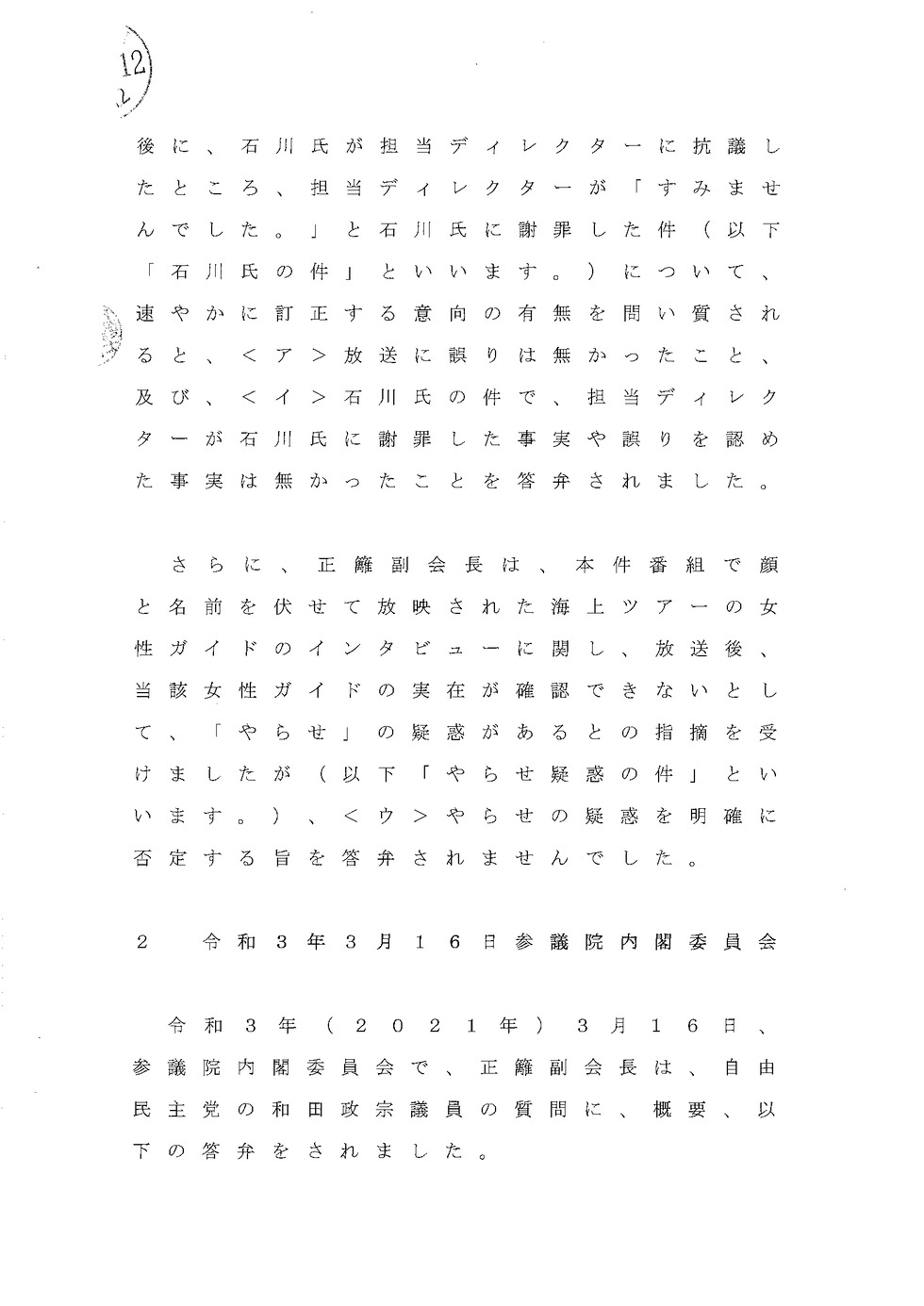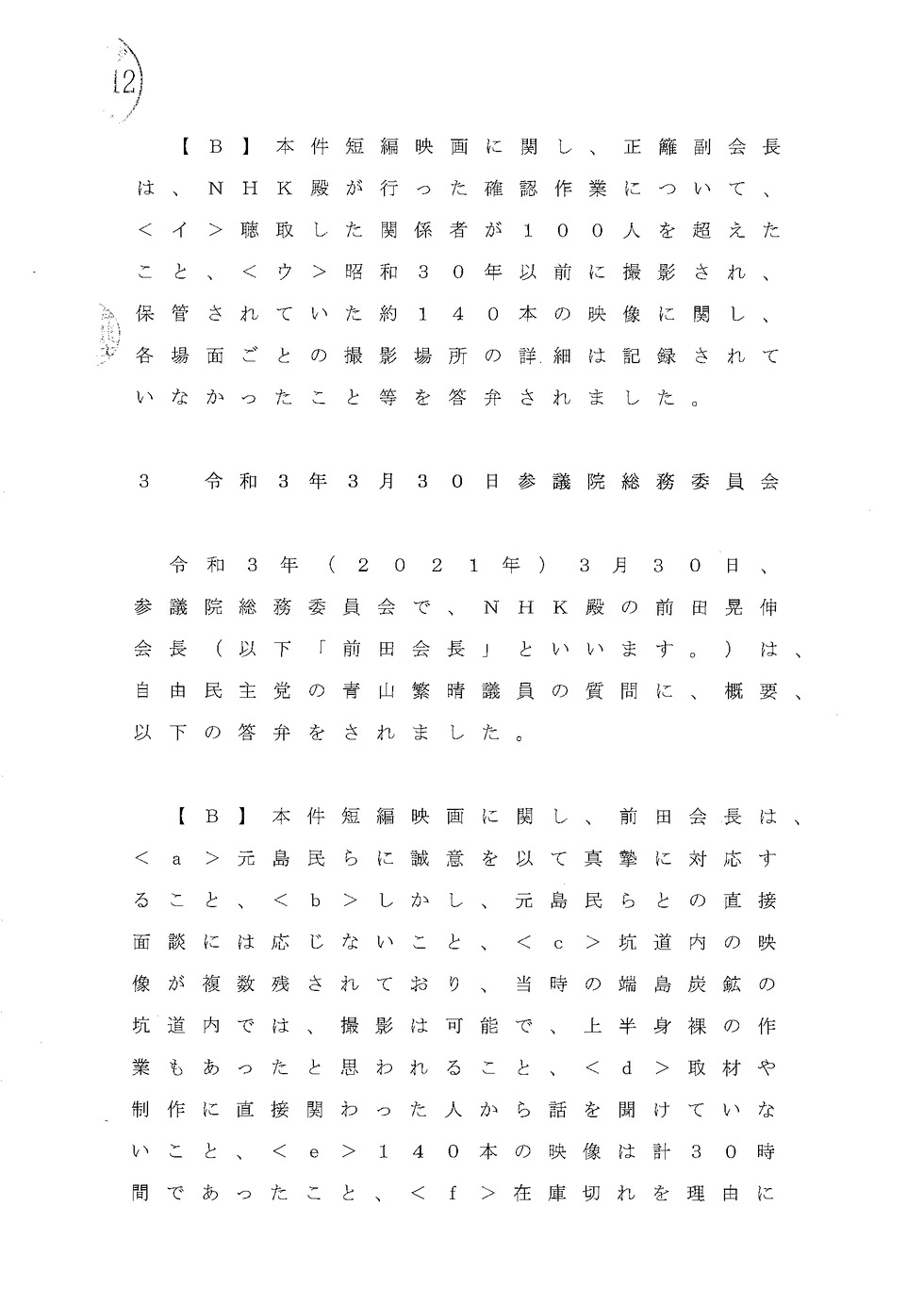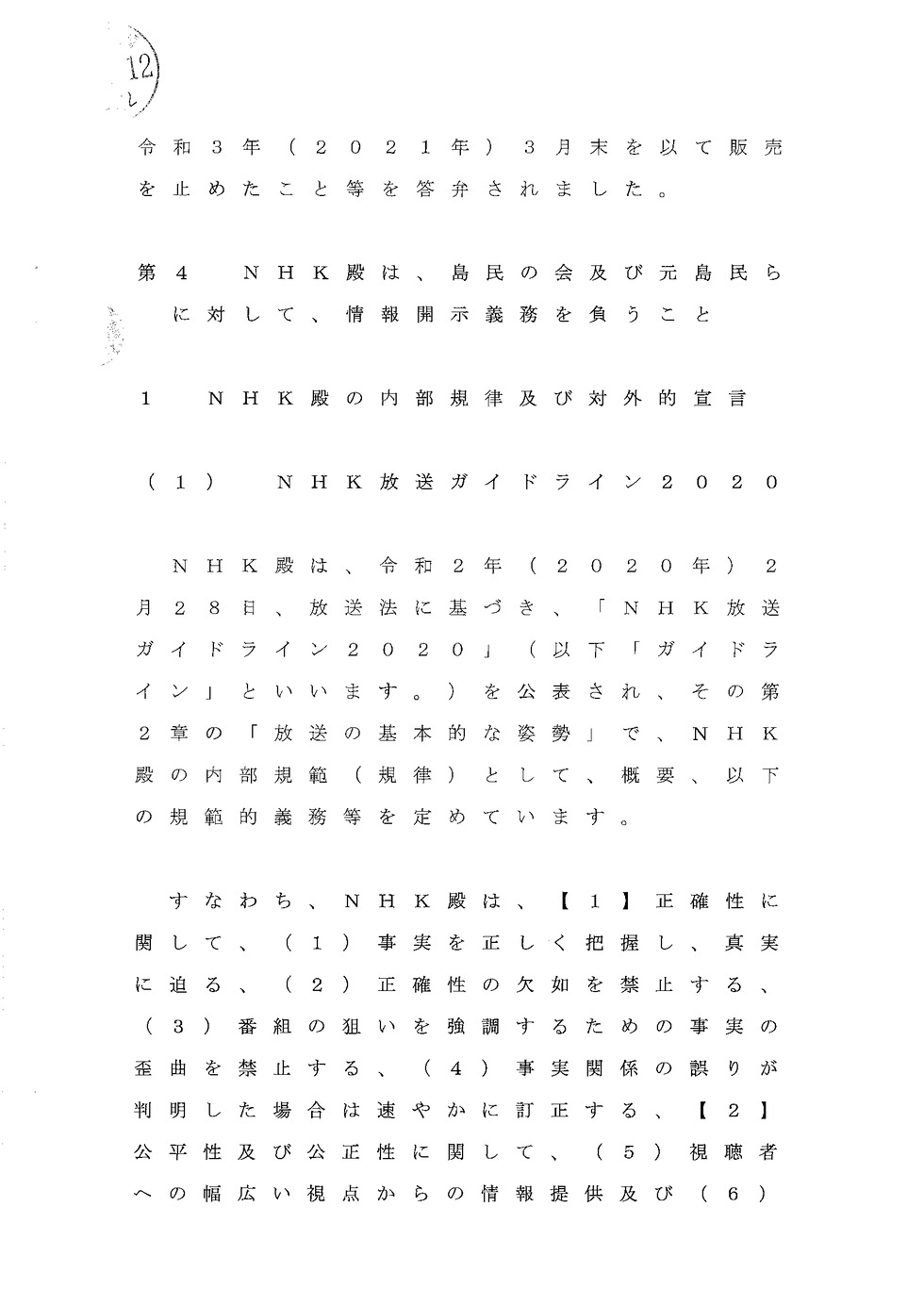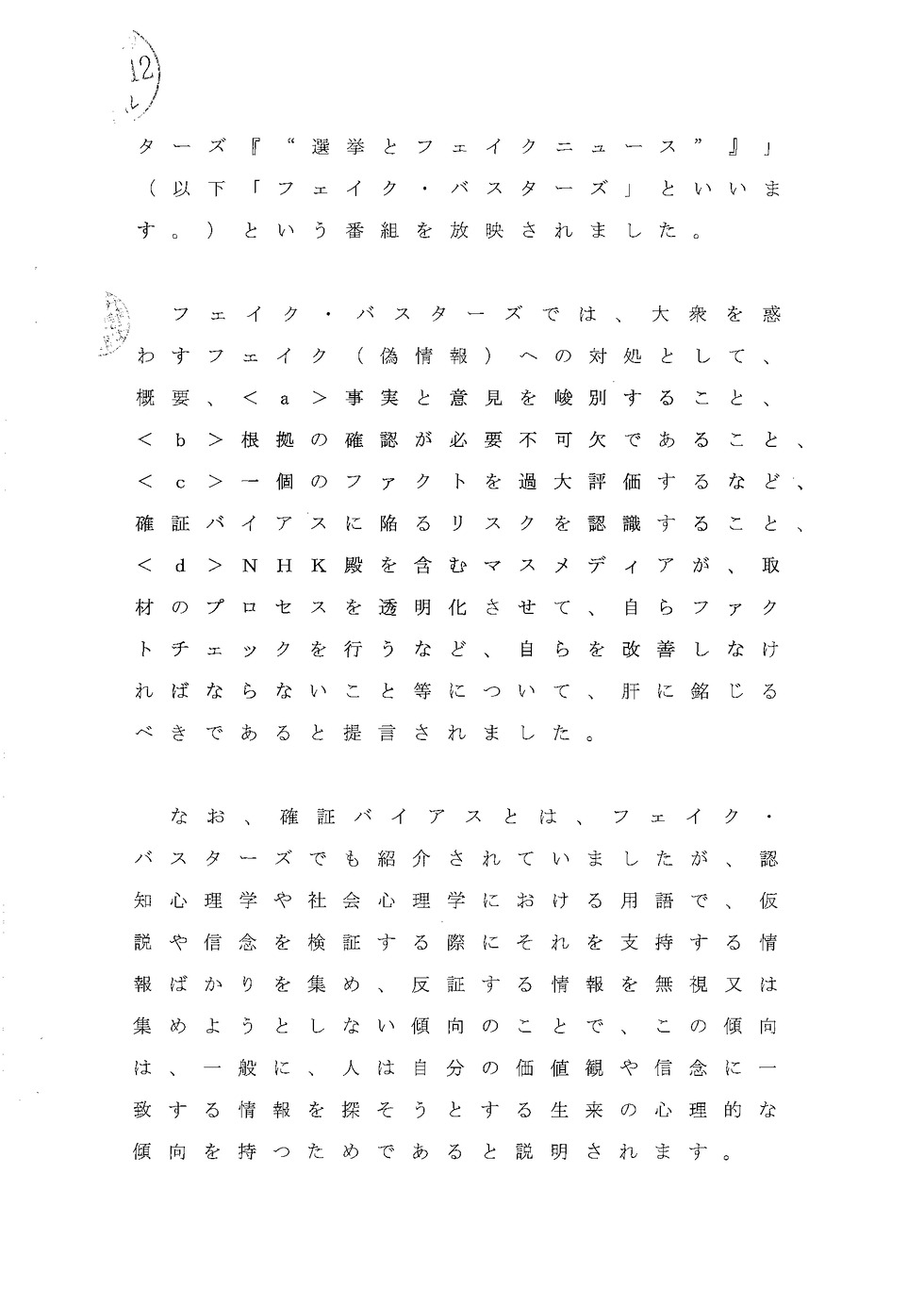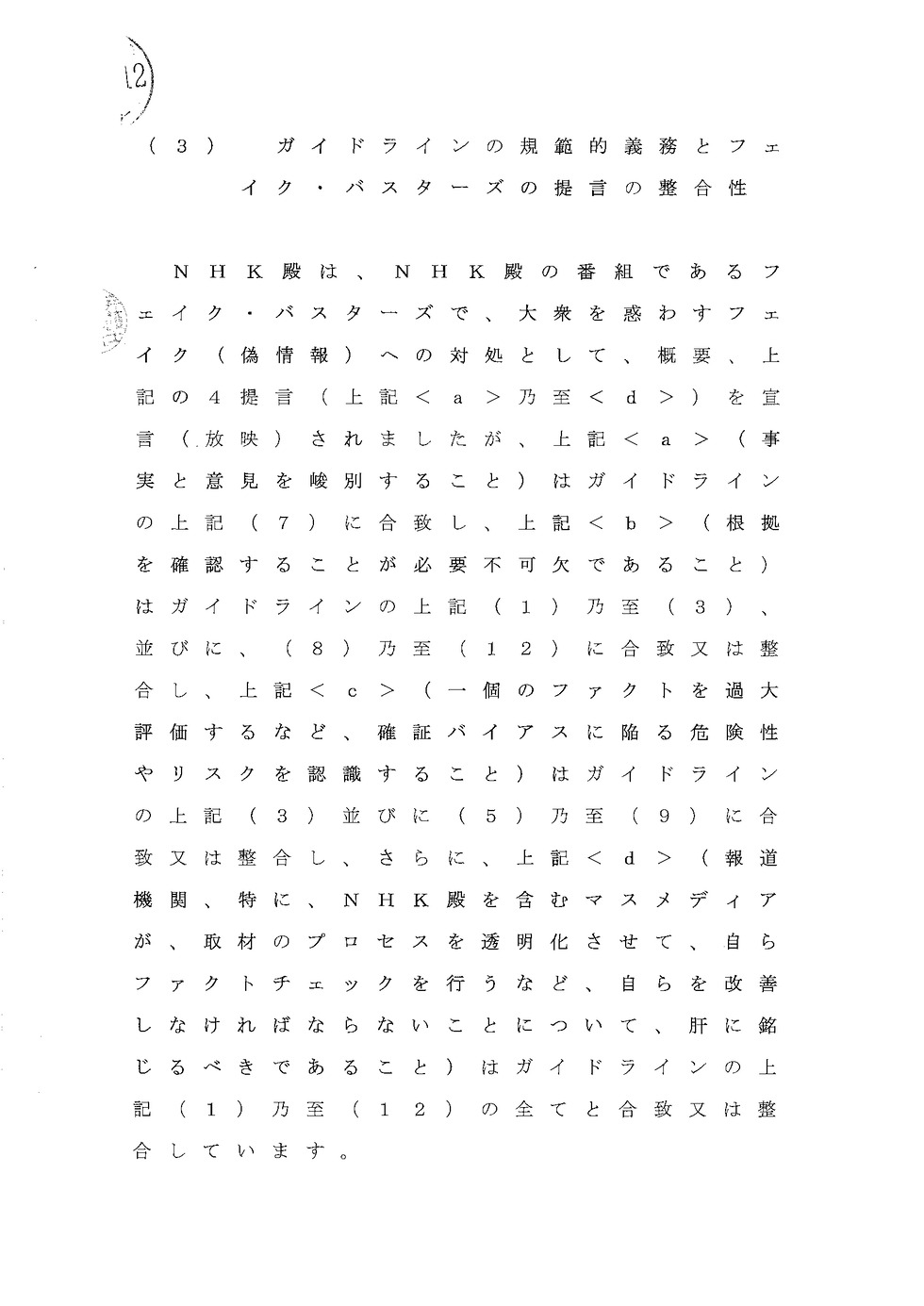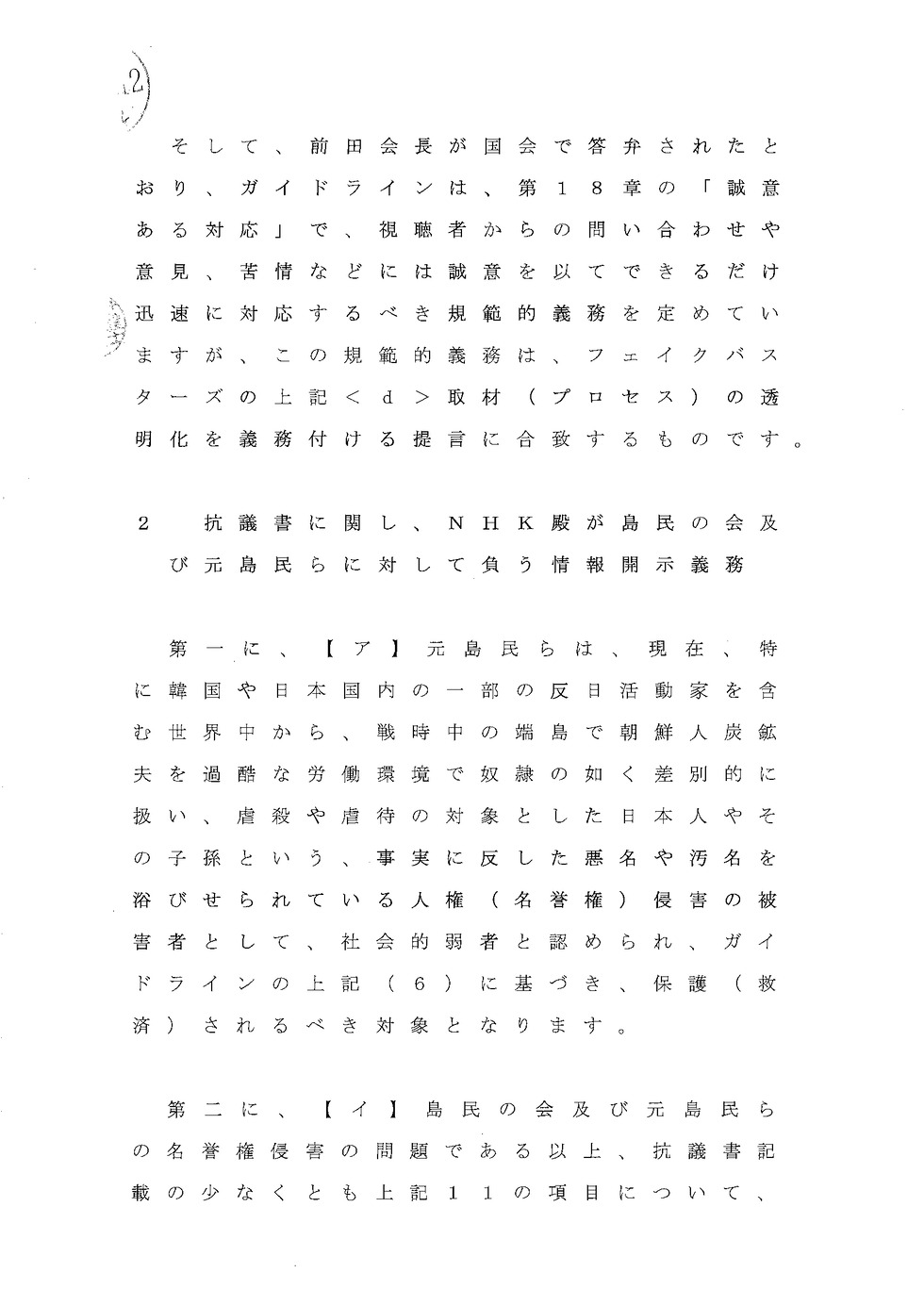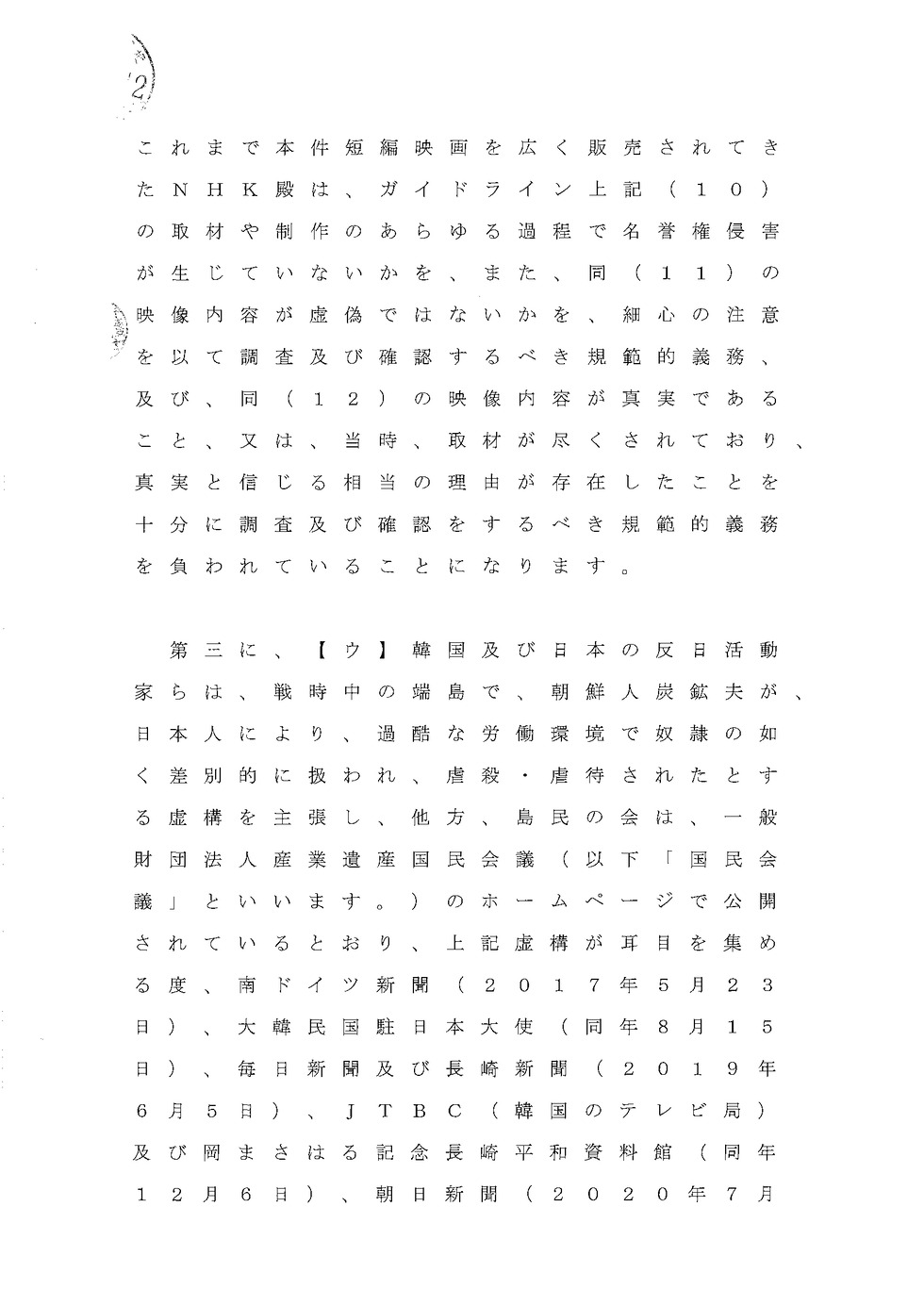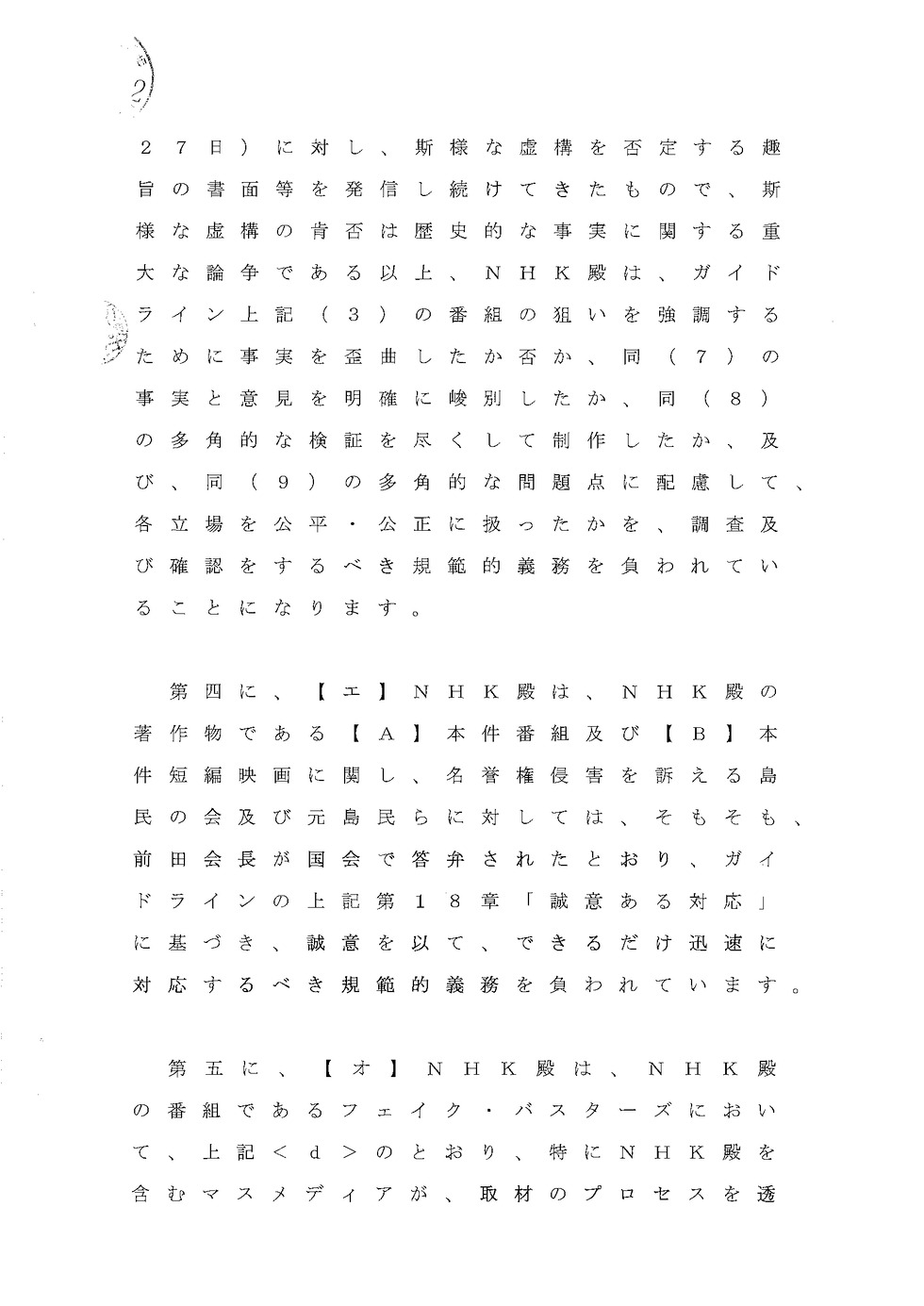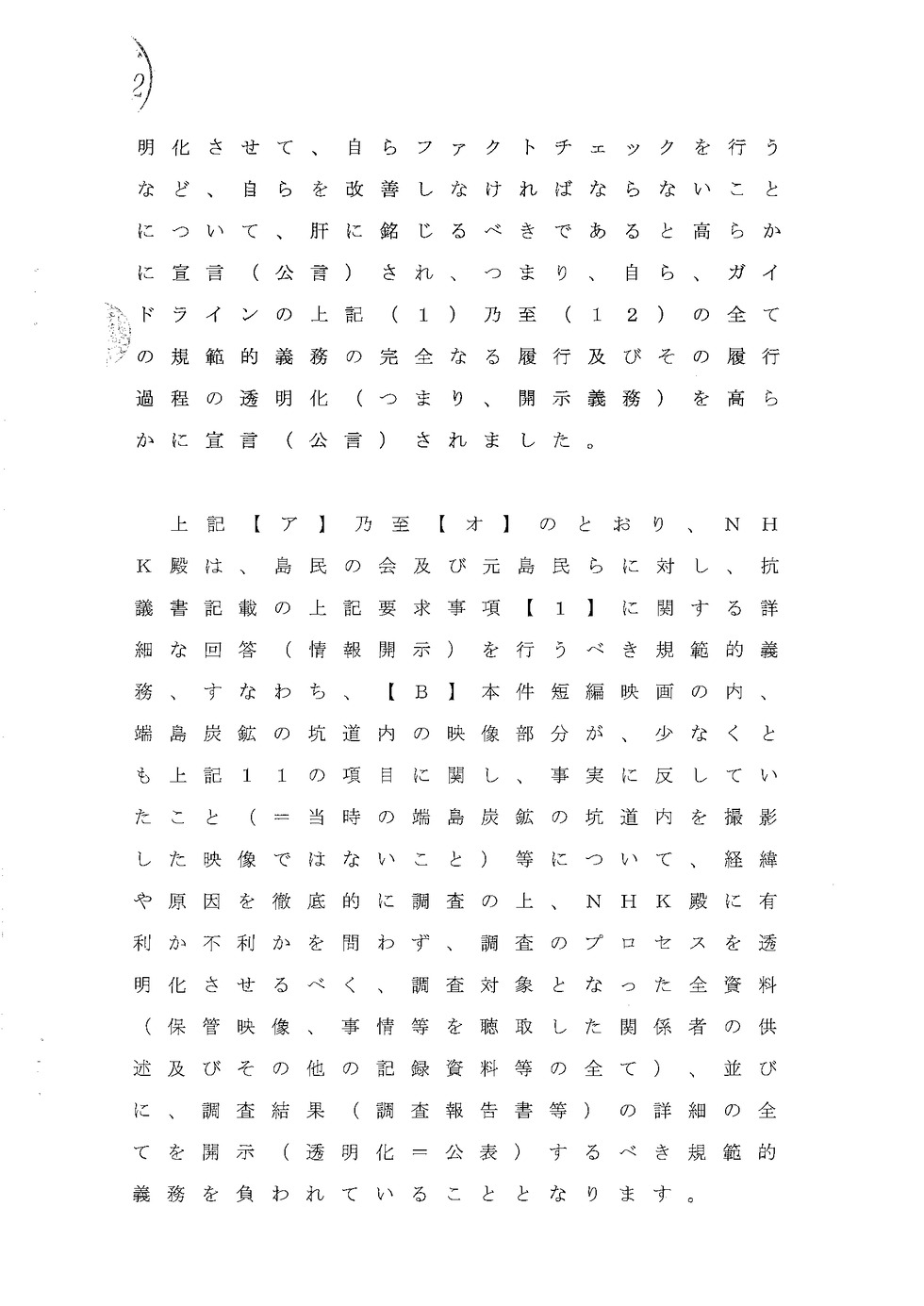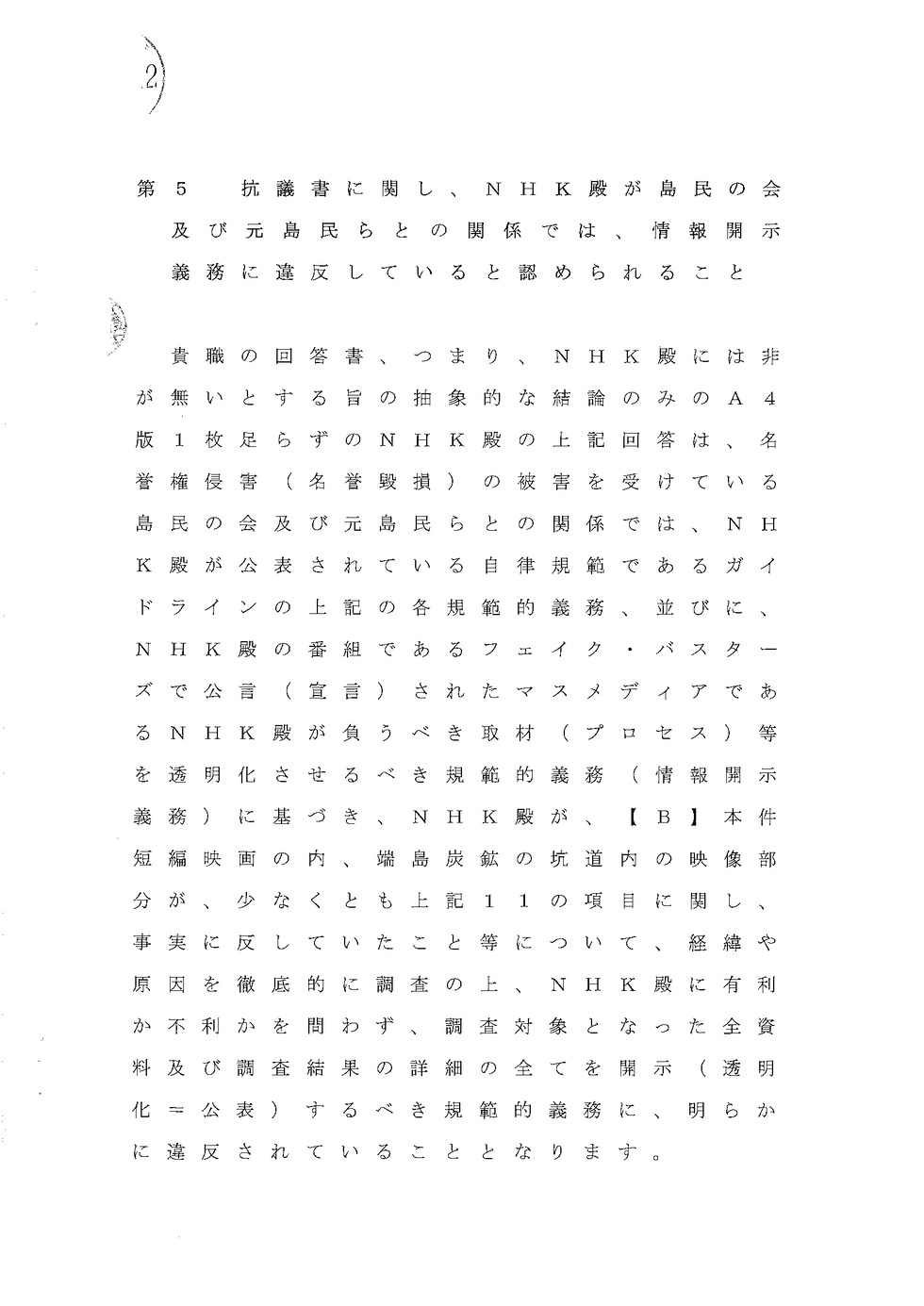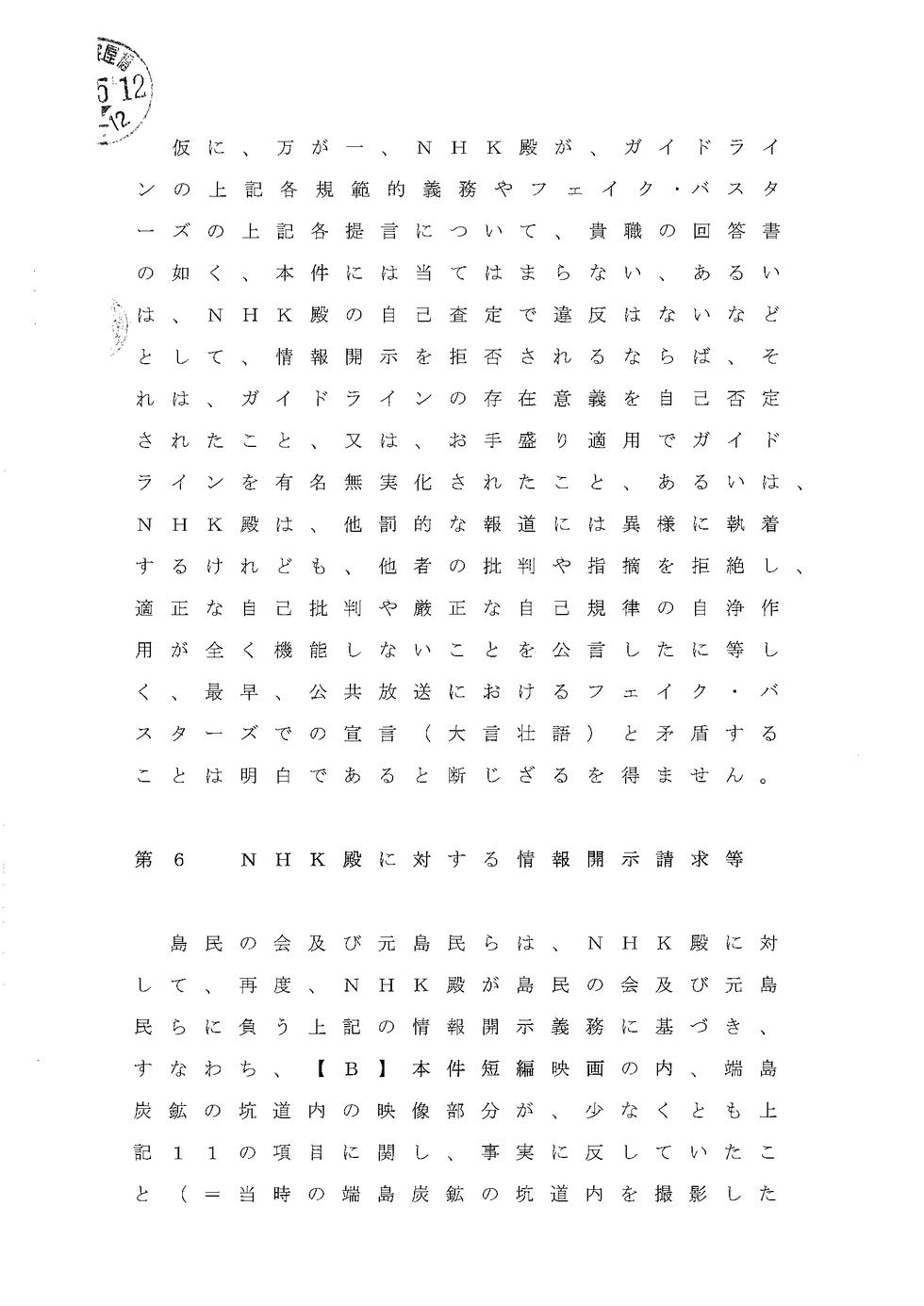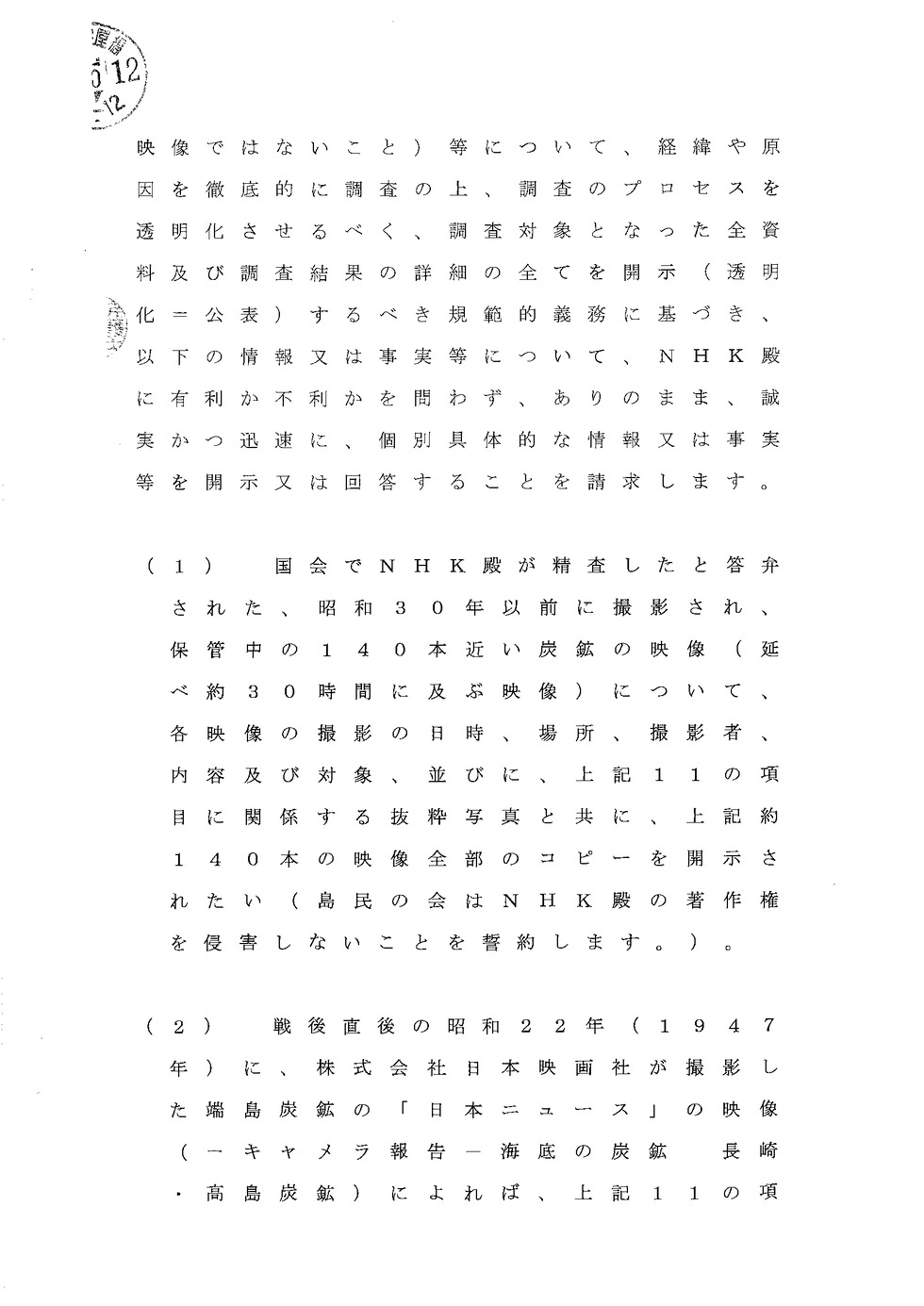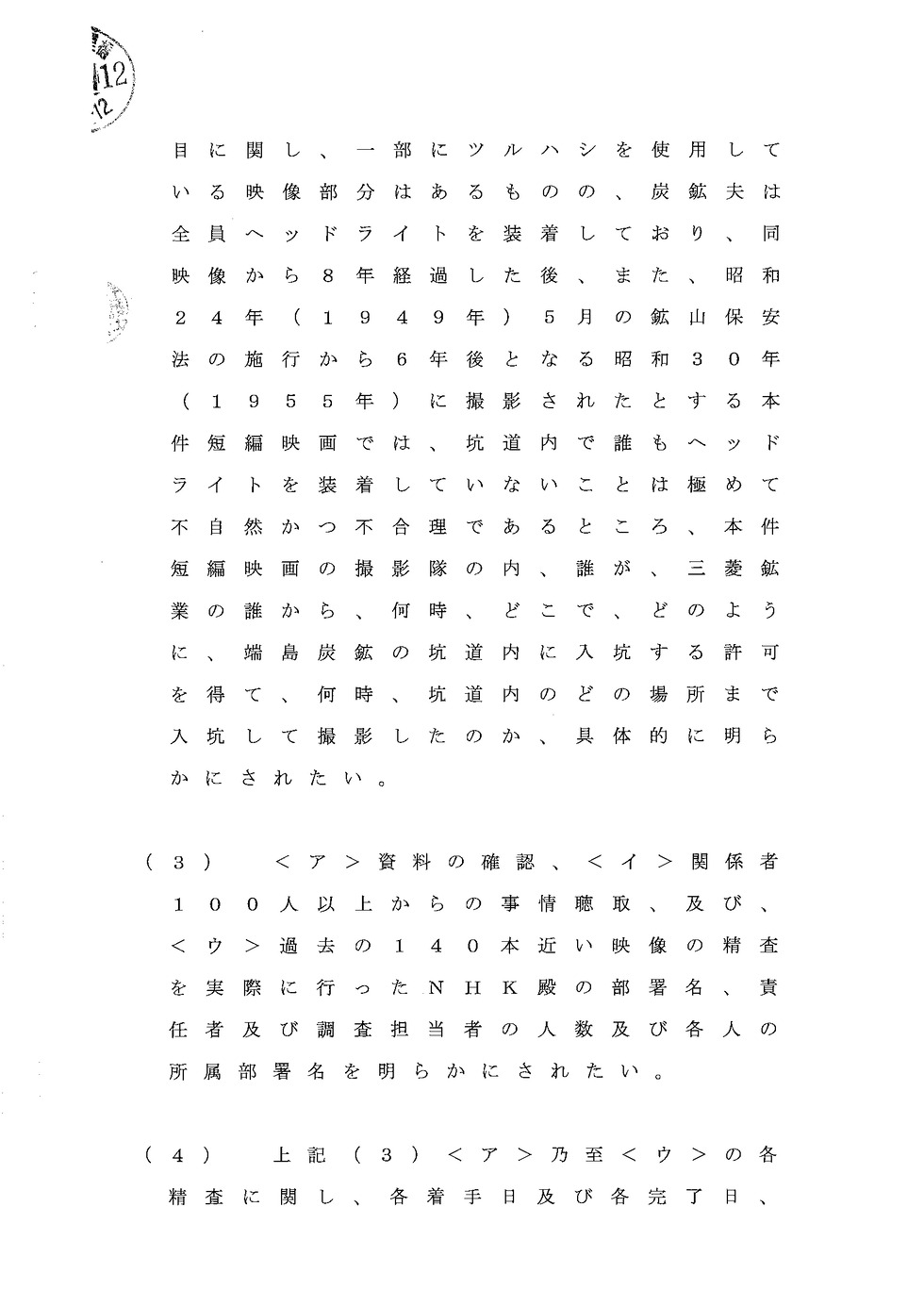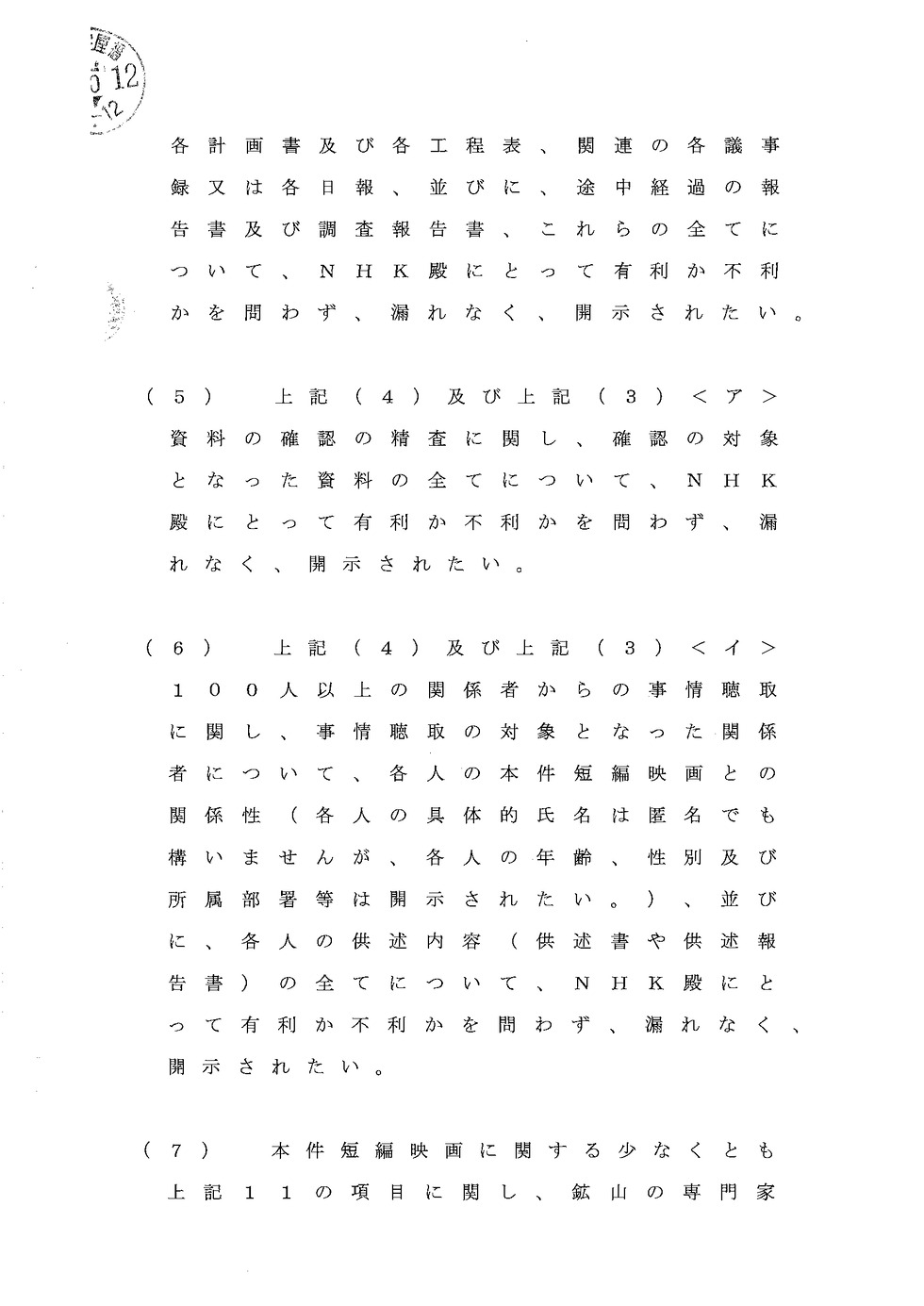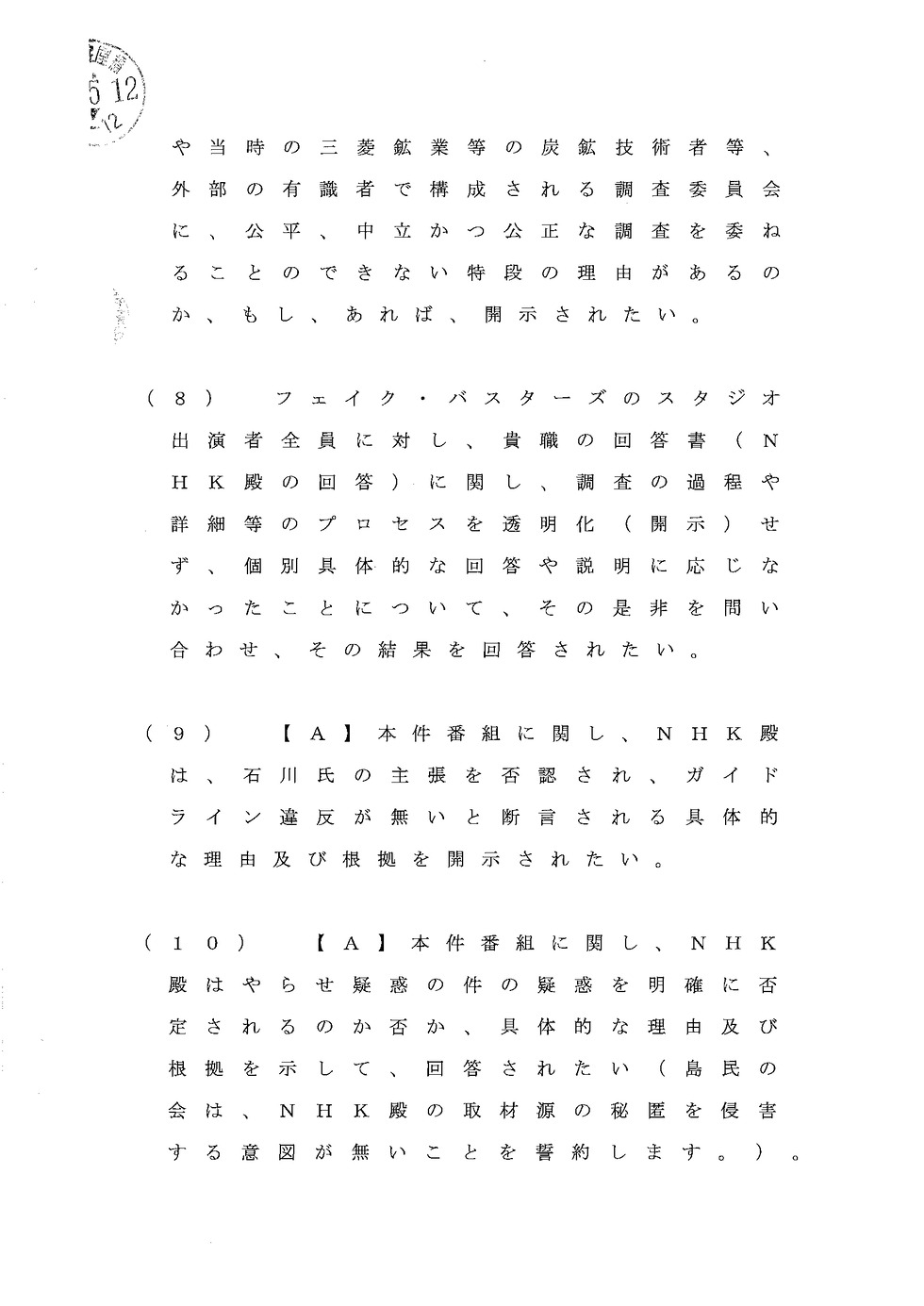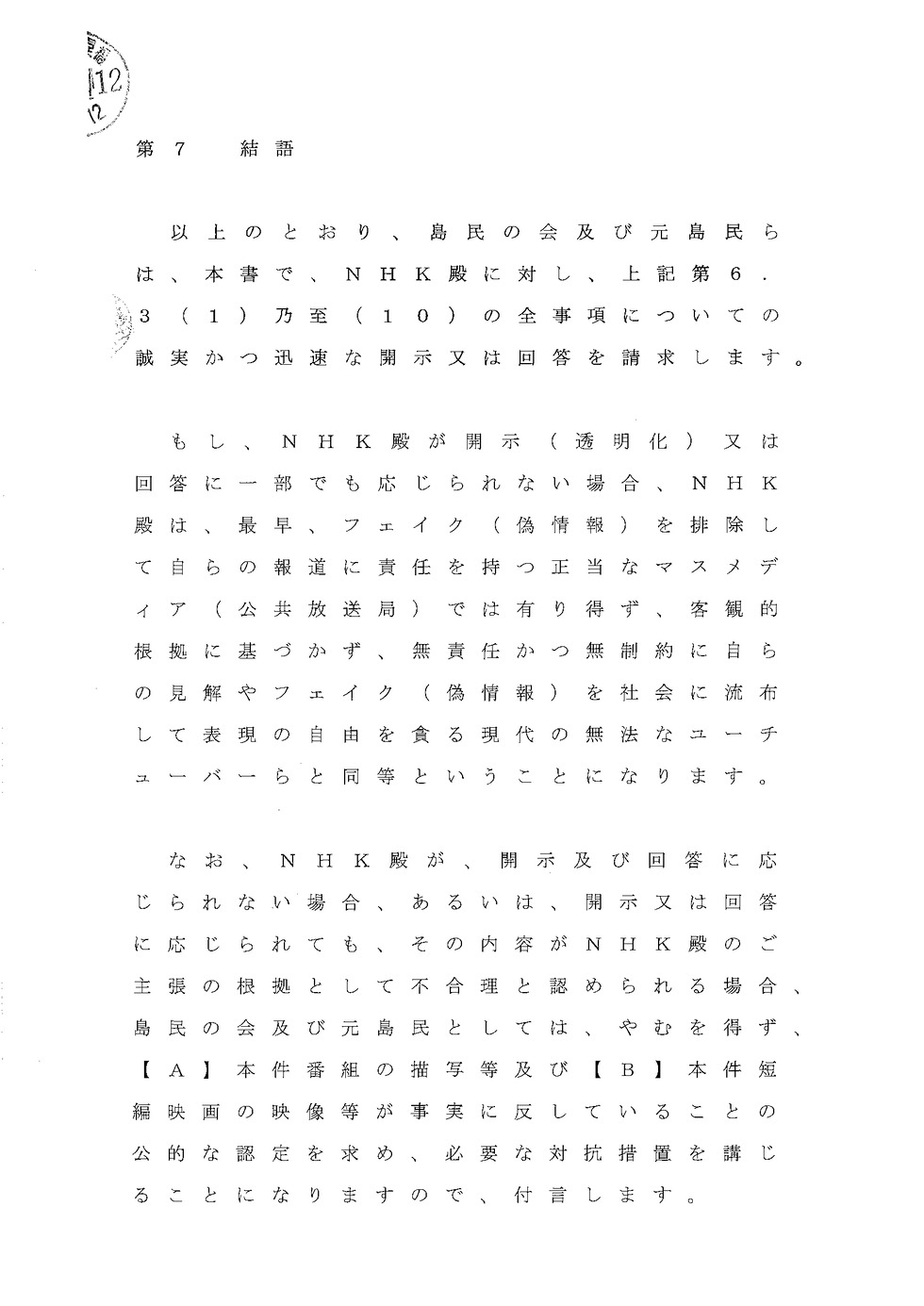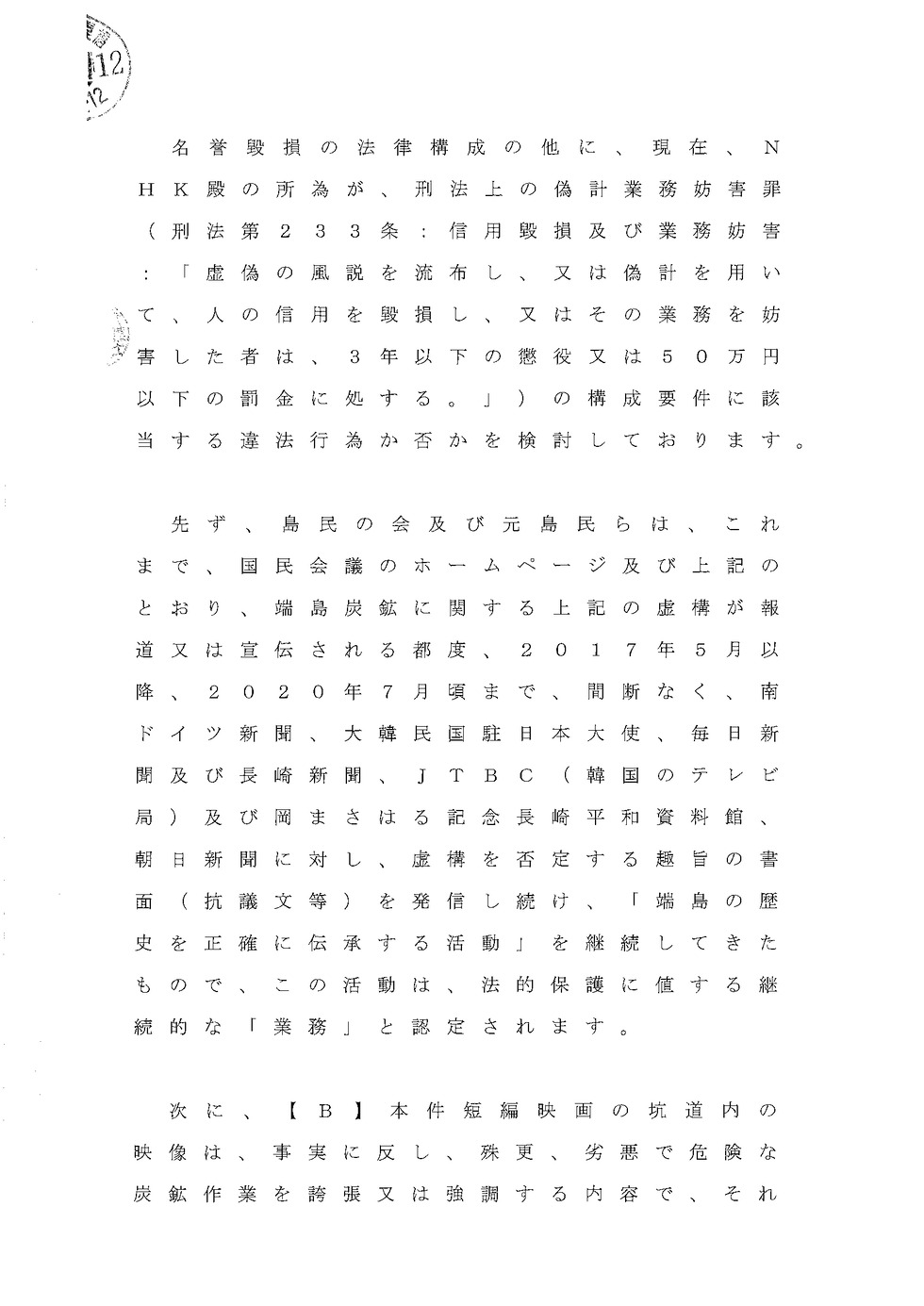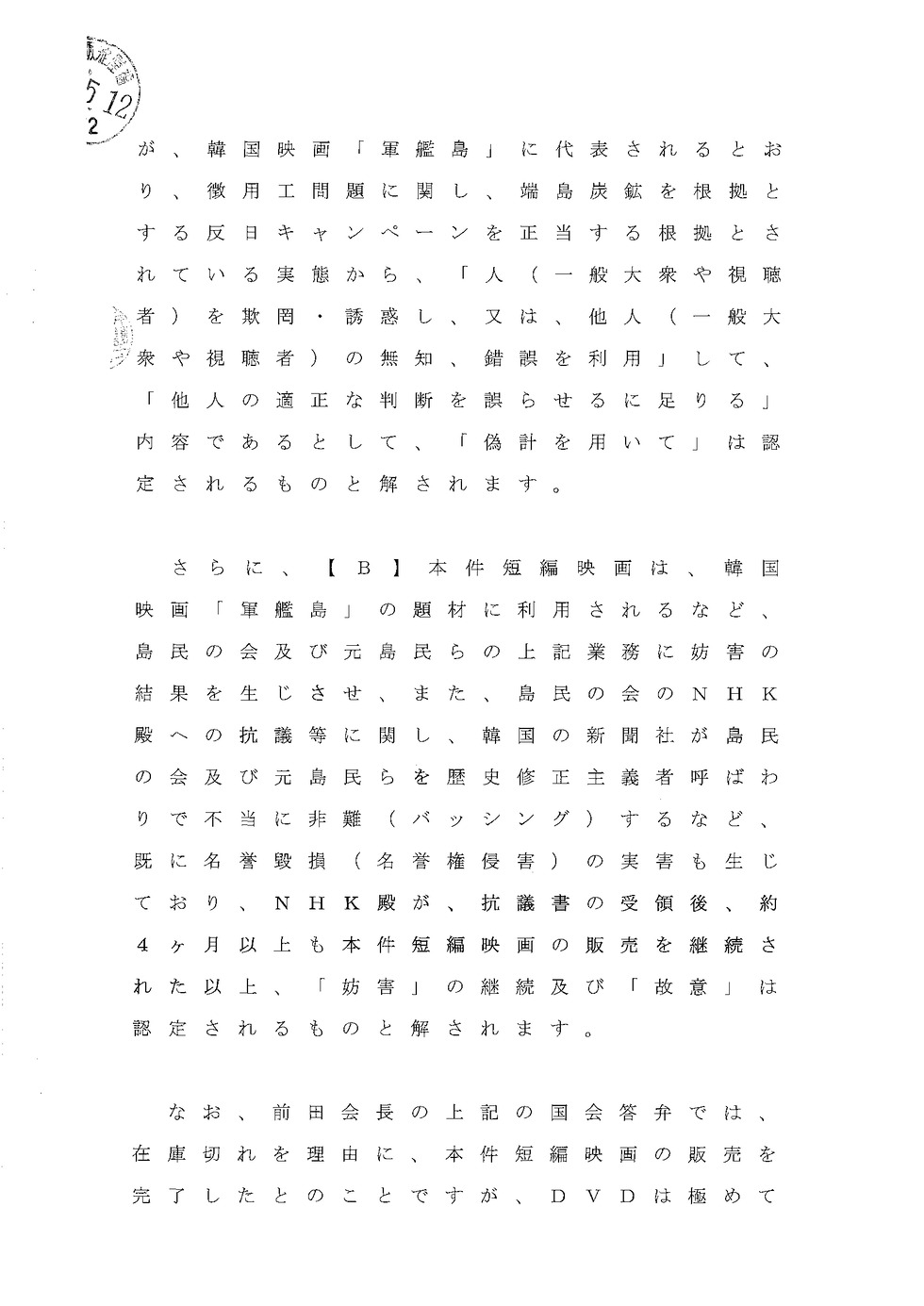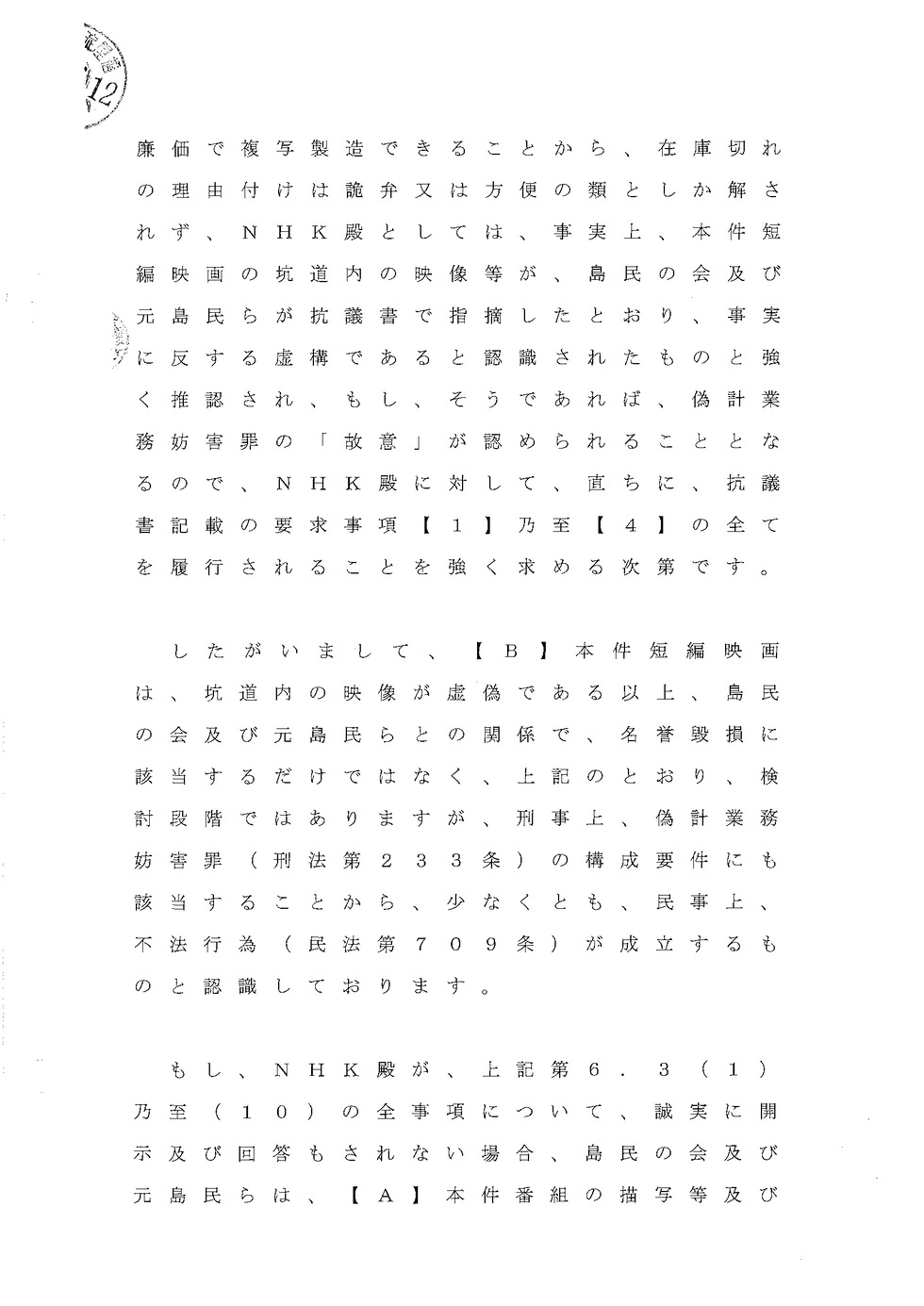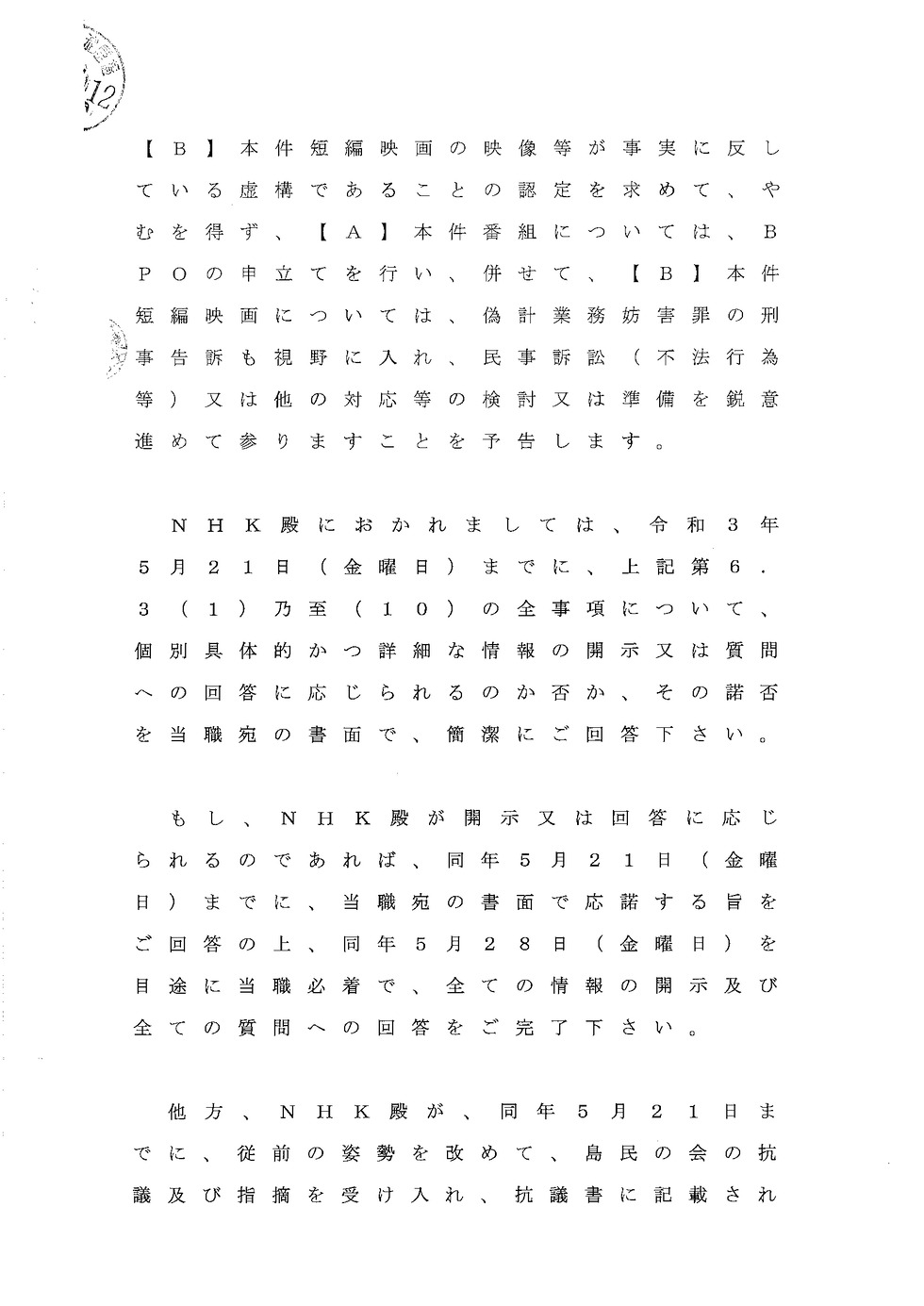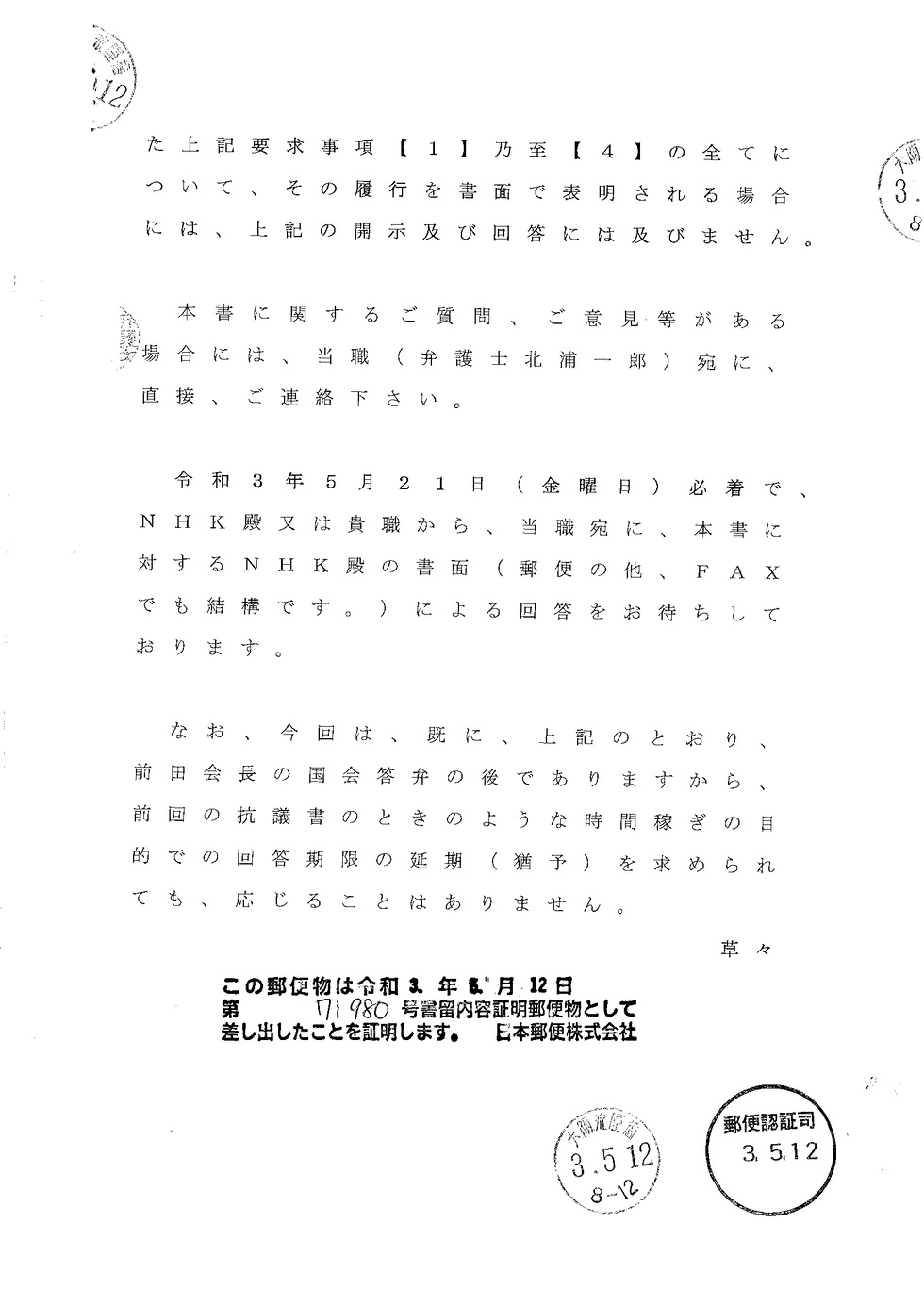Page 1
Page 2
Page 3
Page 4
Page 5
Page 6
Page 7
Page 8
Page 9
Page 10
Page 11
Page 12
Page 13
Page 14
Page 15
Page 16
Page 17
Page 18
Page 19
Page 20
Page 21
Page 22
Page 23
Page 24
Page 25
Page 26
Page 27
Page 28
Page 29
Page 30
Page 31
Page 32
Page 33
Open Letter of Inquiry
(including the purpose of the request for information disclosure)
May 12th, 2021
2 Chome 2-1 Jinnan, Shibuya City, Tokyo, Japan
Japan Broadcasting Corporation (NHK)
(Within Legal Department, General Affairs Bureau of Japan Broadcasting Corporation)
Yasuhiro Umeda, Attorney at Law
Questioner: Hashima Islanders’ Historical Truth
Agent for the Questioner:
4-3-6 Imabashi, Chuo Ward, Osaka City
Yodoyabashi NAO Building 9F
Trust & Service Law Co., Ltd.
TEL06-6229-8811
FAX06-6229-1200
Attorney at Law Ichiro Kitaura
Forgive me for dispensing with the preliminaries, but I hasten to inform you that,
I, Ichiro Kitaura, Attorney at Law, hereby present this letter of inquiry to the Japan Broadcasting Corporation (hereinafter referred to as "NHK") on behalf of the "Hashima Islanders’ Historical Truth” (hereinafter referred to as the "Association of Islander Residents").
No. 1 "Letter of Protest and Notice" of the Association of Island Residents
1) Introduction
In a letter of protest and notice (hereinafter referred to as the "Letter of Protest") dated November 20th, 2020, the Association of Island Residents filed a serious protest against NHK, requesting that NHK correct two programs: [A] the program entitled the "Island of Remembrance: A Trembling Legacy of History" (hereinafter referred to as the “Program," which was aired on October 16th of the same year in the broadcast slot of "Realization!! (Do! Do! Do!)”) produced by NHK (Fukuoka Broadcasting Station) and [B] a short film entitled "the Greenless Island" (hereinafter referred to as the "Short Film," which was included in the DVD named "Gunkanjima Thy Shall Forever Lie Here: From the NHK Archives”), which was also produced by NHK. The Association of Island Residents requested that NHK take corrective measures based on the objective and concrete evidence in accordance with the fact that the description and images of the inside of the tunnels at the Hashima Coal Mine were contrary to the facts.
2) Matters Pointed Out, Matters to be Protested, etc. in the Letter of Protest
In our Letter of Protest, we pointed out the fact that the Program in question [A] attempted to give the impression of the truth—to a fiction that has no basis in fact—about the working environment in the Hashima coal mines during the war by airing several scenes from the Korean film "Gunkanjima" (footage of Japanese and Japanese soldiers forcing and mistreating Korean coal miners) and the statement of a Korean coal miner (deceased) that matched the scenes.
Next, [B] with regard to the footage inside the mine depicted in the Short Film in question, in 1955, <1> it was impossible to obtain permission for filming inside the mine for safety reasons (under the Mine Safety Law enacted in 1949), <2> there was no such thing as working in a loincloth, <3> there was no such thing as using a helmet without a light under the law, <4> comparing the images taken before and after entering the mine, the clothing and helmets are completely different, <5> the mining tool used at the face of a coal was a pick, not a pickaxe, <6> the tunnel at the face of a coal was inclined, <7> the height of the tunnel at the face was about 1.5 meters (the main tunnel was higher), and there was no crawling in the tunnel, <8> on Hashima Island, special explosion-proof light bulbs were legally used, and bare light bulbs were not, <9> blasting technique was not conducted at the face of a coal, <10> the coal powder would turn the faces and clothes of miners completely black, so it was impossible for them to remain clean and white, <11> coal miners did not wear watches while working. Based on these 11 points, they pointed out that the images in the Short Film could not have been taken in the tunnels at the time of the Hashima Coal Mine.
They then pointed out that at least 11 unexplainable fictions were intentionally fabricated in regards to the conditions in the mining tunnels on Hashima Island, and that these untrue images later gave many people false preconceptions, resulting in the fictional impression that Korean miners were forced to work in dangerous conditions as if they were slaves at the Hashima coal mine during the war.
Furthermore, in South Korea (Busan), as a result of this Short Film being shown as a visual material in an official archive (the National Memorial Museum of Forced Mobilization under Japanese Occupation), an anti-Japanese film titled "Gunkanjima"—to condemn Japan for their crimes—was produced and screened using this Short Film as a material, as if Japanese soldiers (Japanese soldiers were not stationed on Hashima Island during the war) had treated Korean conscripted workers like slaves and abused their human rights, such as committing mass murder. As a result, it incited intense anti-Japanese sentiment.
Similarly, in [A] this Program, Mr. Seo Jeong-U, who was alive at the time, claimed, "Inside the Hashima coal mine was so small that I had to dig face down, and I thought I would never make it back alive.” [B] As he made a fictional statement in line with the video footage in the Short Film in question, but such a statement has been aired without confirming the objective basis behind his statement.
3) Demands, etc. in the Letter of Protest
In the Letter of Protest, the Association of Island Residents demanded that NHK, [B] in relation to the footage of alleged mining tunnels in the Short Film, [1] thoroughly investigate the circumstances and causes of the footage including the fact that it was not actually taken inside the mining tunnels of the Hashima coal mine, and publish the results of the investigation; [2] promptly report publicly to the world, including South Korea, that the footage was fictional and make the correction known to the public; and [3] conduct a complete recovery of all copies of the film from the owners of the footage, including the National Memorial Museum of Forced Mobilization under Japanese Occupation in South Korea (Busan); and [4] NHK's [B] fictions (misunderstandings and bad names: [A] including the manipulation of the impressions of the Program in question) about Hashima Island, which were spread worldwide using the Short Film in question as a starting point (source of information). Due to these fictions, the former island residents and their descendants, who lived on Hashima Island during the war, and each and every one of them, have had their pride and self-respect of living on Hashima Island crushed and were deeply hurt over a long period of time. We demanded that the company shall formally, sincerely, and politely apologize in writing to the former island residents and all of their descendants who lived on Hashima Island during wartime, and also to take appropriate measures for their comfort. As mentioned above, we demanded the aforementioned points from [1] to [4].
The Association of Island Residents and the former residents of the island hereby also strongly demand that NHK promptly fulfill the requirements of [1] through [4] stated above.
No. 2 NHK’s Response, etc. to the Letter of Protest
1) NHK’s Response, etc.
In response to our Letter of Protest, NKH wrote in its response to our letter dated December 25th, 2020 (hereinafter referred to as the "Letter of Response") that it had “reviewed materials related to the ‘Greenless Island,’ interviewed people involved in the production of the film, and carefully examined footage of coal mines filmed and stored prior to the 1950s. As a result, it was not confirmed that footage shot at other coal mines was used in the ‘Greenless Island,’ as you have pointed out," and "we believe that the 'Greenless Island' was produced and broadcast based on the coverage of Hashima Island in the City of Nagasaki at that time.”
2) The Perception (Dissappointment), etc. of the former island residents in response to the response of NHK
It is a known fact that NHK is a public broadcaster that, unlike commercial broadcasters, is funded by the people's subscription fees and is therefore required to be fair and impartial, or in other words, has an extremely strong influence on society.
The Association of Island Residents and the former island residents demand that NHK—a public broadcaster with extremely strong influence on society—[B] conduct a thorough and sincere investigation and interview with a humble attitude toward the facts in regards to the above-mentioned 11 video clips of the Short Film, as pointed out in the Letter of Protest. We were expecting that you would respond, answer, or explain in a fair and impartial manner to the Association of Island Residents and the former island residents, providing them with objective evidence in detail and promptly fulfilling all of the requirements of [1] through [4] above, to the satisfaction of everyone.
However, NHK, a mass media company that is required to be highly impartial, fair, and public, did not respond or explain in any concrete way, but only answered in an abstract way that they had <a> confirmed the materials, <b> interviewed the people involved, and <c> examined the past footage, and only forcefully stated their conclusion that they had properly covered, produced, and broadcast the film.
In short, in your Letter of Response, NHK did not provide any objective evidence for any of the 11 suspicious footages in the Short Film in question, and it only forced an abstract conclusion that NHK was not at fault.
3) Purpose of this Letter
In light of the above, the Association of Island Residents and the former island residents have written this document to reiterate to NHK to show that [A] the portrayal and manipulation of impressions of the working environment in the tunnels of the Hashima Coal Mine during the war (including the alleged mistreatment and mass murder of Korean miners) in the Program in question is contrary to the facts, and [B] the images of the working environment in the mining tunnels of the Hashima Coal Mine in 1955 in this short film are also contrary to the facts. If NHK does not change its previous refusal to comply with the demands, we would like to request that you provide us with objective and concrete evidence, including the results of the investigation into the protest and answers to the questions in this document. If NHK refuses to comply with our request, we would like to request NHK to disclose objective and concrete evidence, including the results of the investigation into our protest and the answers to the questions in this document. The purpose of this document is to have you respond to the disclosure of the above-mentioned evidence, to have the Association of Island Residents and the former island residents make a detailed analysis of the disclosed evidence, we will debate once again, and for you to finally come to the conclusion that [A] the description of the Program in question and [B] the images of the Short Film in question are both contrary to the facts.
Therefore, in this document, we are mainly concerned with [B] the images of the Short Film in question, but as in the Letter of Protest, we also request NHK to take appropriate measures with regard to [A] the depiction of the Program in question.
No. 3 NHK’s Response in the Diet to the Letter of Protest
NHK gave the following reply to the Diet in regards to the Letter of Protest containing the claims, points, and demands of the Association of Island Residents and former island Residents.
1) Budget Committee, House of Representatives, February 25, 2021
On February 25th, 2021, at the Second Subcommittee of the Budget Committee of the House of Representatives, the Vice Chairman of NHK named Satoru Masagaki (hereinafter referred to as "Vice Chairman Masagaki") made the following reply to a question from Mio Sugita, a member of the Liberal Democratic Party.
[B] With regard to the Short Film in question, Vice Chairman Masagaki stated that (1) the National History Museum of Forced Mobilization Under Japanese Occupation in South Korea had not obtained permission for use of the film and had not paid NHK a fee for its use, and (2) the Association of Island Residents had requested verification of the portion of the video footage concerning the Hashima coal mine, claiming that it was not true. You stated that you had done everything you could to verify the fact, including <a> checking the materials; <b> interviewing the people involved; and <c> carefully examining the nearly 140 videos of the coal mine that were taken prior to 1955 and stored in the archive. However, when asked whether it was appropriate for NHK to conduct only an internal investigation and not have an external third party verify the Program, he did not answer whether it was appropriate or not and avoided answering the question.
[A] In terms of this Program in question, Vice Chairman Masagaki explained that Mr. Azuma Ishikawa (a former island resident whose father worked at the Hashima coal mine and resided on Hashima Island until his high school days: hereinafter referred to as “Mr. Ishikawa”), a member of the Association of Island Residents, whose interview was aired in this program, explained that there was no discrimination against Korean miners and their family members living together on Hashima Island during the interview, but that part was cut out in the aired program. In addition, the interviewer asked a question under the pretense of a general inquiry, “Do you dislike the negative legacy being passed on to your hometown?" and Mr. Ishikawa said, "I do not like it when it comes out clearly, but we believe it never happened.” However, only the part where Mr. Ishikawa answered was extracted and broadcast. After the broadcast, Mr. Ishikawa protested to the director in charge, and the director directly apologized to Mr. Ishikawa, saying, "I am sorry” (hereinafter referred to as the “Incident of Mr. Ishikawa”). Later on, when we asked whether or not NHK intended to promptly correct the error in the broadcast, NHK has replied that <a> there was no error in the broadcast, and <b> not once did the director in charge apologized to Mr. Ishikawa or admitted the error in the Incident of Mr. Ishikawa.
Furthermore, Vice President Masagaki pointed out that the interview with the female guide of the marine tour, whose name and face was not revealed in the Program, was suspected to be a "fake" (hereinafter referred to as the "Allegation of the Fake Interview") because the real existence of the female guide could not be confirmed after the broadcast. <c> Nonetheless, he did not clearly deny the Allegation of the Fake Interview.
2) Cabinet Committee, House of Councillors, May 16th, 2021
On March 16, 2021, at the Cabinet Committee of the House of Councillors, Vice Chairman Masagaki made the following response to a question from Mr. Masamune Wada of the Liberal Democratic Party.
[B]With regard to the Short Film in question, Vice Chairman Masagaki answered that NHK had confirmed that: <b> more than 100 people had been interviewed; and <c> the details of the locations of each scene had not been recorded for the approximately 140 videos that had been shot and stored prior to 1955.
3) General Affairs Committee, House of Councillors, March 30th, 2021
On March 30, 2021, at a meeting of the General Affairs Committee of the House of Councillors, the Chairman of NHK named Terunobu Maeda (hereinafter referred to as "Chairman Maeda") responded to a question from the member of the Liberal Democratic Party named Shigeharu Aoyama as follows.
[B] With regard to the Short Film in question, Chairman Maeda stated that: <a> he would respond sincerely to the former island residents in good faith; <b> he would not, however, agree to a direct interview with them; <c> there are several images of the mining tunnel, and it is believed that filming was possible in the mining shaft at the time, and that some of the work was done in the nude; and <d> He also stated that he had not been able to speak to anyone who was directly involved in the filming or production, that the 140 videos were 30 hours in total, and that he had stopped selling them at the end of March 2021 because he had run out of stock.
No. 4 NHK is Obligated to Disclose Information to the Association of Island Residents and Former Island Residents.
1) Internal Discipline and External Declaration of NHK
(1) NHK Broadcasting Guidelines 2020
On February 28th, 2020, NHK published the "NHK Broadcasting Guidelines 2020" (hereinafter referred to as the "Guidelines") based on the Broadcasting Act, and in Chapter 2, "Basic Stance on Broadcasting," the following normative obligations are outlined as NHK's internal standards (regulations).
In other words, with regard to [1] accuracy, NHK said that it (1) grasps the facts correctly and gets to the truth, (2) prohibits lack of accuracy, (3) prohibits distortion of facts to emphasize the program's aims, and (4) corrects factual errors as soon as they are discovered. [2] With regard to fairness and impartiality, the following normative obligations are imposed: (5) provide information to viewers from a wide range of viewpoints, (6) assume the viewpoints of the socially vulnerable, (7) clearly distinguish between facts and opinions, (8) if there are conflicting opinions on historical events, matters, or events, or conflicting academic views, verify them from multiple perspectives before broadcasting, and (9) if a matter is the subject of a trial or controversy, clarify the issues from multiple perspectives and treat each position fairly and impartially. These normative obligations in (1) through (9) above are imposed.
Furthermore, with regard to [3] Respect for human rights, the following obligations are imposed: (10) to take the utmost care in all processes of reporting and production to prevent unjustified damage to reputation; (11) to warn of violations of the right to reputation (the right of individuals and groups not to have their social reputation violated) (defamation) if the content of the broadcast is false; and (12) Carefully consider that the content is true, or that there are reasonable grounds for believing it to be true, and make sure not to unfairly damage reputation. These normative obligations in (10) through (12) above are imposed.
(2) Proposals in NHK's Program Titled "Fake Busters: Election and Fake News”
On December 19th, 2020, NHK aired a terrestrial program entitled "Fake Busters: Election and Fake News" (hereinafter referred to as "Fake Busters").
In order to deal with so-called ‘fake’ (false information) that misleads the public, Fake Busters outlines the following points: <a> distinguish between fact and opinion, <b> confirmation of evidence is essential, <c> recognize the risk of confirmation bias, such as overestimating a single fact, and <d> make sure that the mass media, including NHK, are aware of the process of reporting. It suggested that the mass media, including NHK, ought to improve themselves by making their reporting processes transparent and conducting their own fact-checking.
Confirmation bias, which was also introduced in Fake Busters, is a term in cognitive psychology and social psychology that refers to the tendency to collect only information that supports a certain hypothesis or belief when testing it, and also to ignore or not collect information that disproves it. This tendency is generally explained as an innate psychological tendency to seek out information that is consistent with one's values and beliefs.
(3) Consistency Between the Normative Obligations of the Guidelines and the Recommendations of Fake Busters
NHK declared (broadcasted) the above four recommendations (from <a> to <d> above) in its program titled "Fake Busters" to deal with ‘fake’ (false information) that misleads the public. The above <a> (making a distinction between facts and opinions) is consistent with the above (7) of the Guidelines, the above <b> (confirming evidence is essential) is consistent with or aligned with the above (1) through (3) and (8) through (12) of the Guidelines, and the above <c> (recognizing the risk or danger of confirmation bias, such as overestimating a single fact) is consistent with or aligned with the above (3) and (5) through (9) of the Guidelines. In addition, the above <d> (that media organization, especially mass media including NHK, ought to be mindful of the need to improve themselves by making their reporting processes transparent and conducting their own fact-checking) is consistent with all of the above (1) through (12) of the Guidelines.
As Chairman Maeda stated in the Diet, the Guidelines stipulate in Chapter 18, "Respond in Good Faith," a normative obligation to respond to inquiries, opinions, and complaints from viewers in good faith and as quickly as possible, and this normative obligation is in line with the recommendation of Fake Busters to make the reporting (process) transparent as stated in <d> above.
2) NHK's Obligation to Disclose Information to the Association of Island Residents and Former Island Residents in Regards to the Letter of Protest
Firstly, [Ⅰ] the former island residents are now recognized as socially vulnerable victims of human rights violations (defamation) who are subject to protection (and relief) in accordance with the (6) above of the Guidelines, as they are being subjected to a bad name and stigma—that are contrary to the facts—from all over the world, especially from South Korea and some anti-Japanese activists in Japan, as the Japanese people and their descendants who allegedly treated the Korean miners like slaves, who discriminated against them under harsh working conditions, and who subjected them to mass murder and abuse during the war on Hashima Island.
Secondly, [Ⅱ] since this is an issue of defamation of the Association of Island Residents and the former island residents, NHK, which has been selling the Short Film widely, ought to check whether the defamation occurred in any of the processes of the interview and production of the above guideline (10) and whether the content of the video of (11) above is not false. NHK, which has widely marketed the Short Film in question, has a normative obligation to investigate and confirm with the utmost care whether there is any defamation caused in the process of interview and production as stated in (10) above, and whether the content of the video as stated in (11) above is not false, and a normative obligation to investigate and confirm sufficiently that the content of the video as stated in (12) above is true, or that there were reasonable grounds to believe that the interview was exhaustive and true at the time.
Thirdly, [Ⅲ] Korean and Japanese anti-Japanese activists claimed the fiction that Korean miners were treated discriminatorily like slaves, massacred and abused by the Japanese under harsh working conditions on Hashima Island during the war. On the other hand, the Association of Island Residents, as published on the website of the National Congress of Industrial Heritage (hereinafter referred to as the "National Congress"), has sent letters to the South German Newspaper (May 23rd, 2017), the ambassador of the Republic of Korea to Japan (August 15th, 2017), the Mainichi Newspaper and the Nagasaki Newspaper (June 5th, 2019), JTBC (a Korean television station) and the Oka Masaharu Memorial Nagasaki Peace Museum (December 6th, 2019), and the Asahi Newspaper (July 27th, 2020) to deny such fictions whenever the above fiction attracts attention. Since the affirmation or denial of such fictions is a serious dispute in regards to historical facts, NHK has been sending out written documents to the following parties to deny such fictions: whether or not it distorted facts to emphasize the Program's aims as stated in Guideline (3) above, whether or not it made a clear distinction between facts and opinions as stated in Guideline (7) above, whether or not it produced the program after thorough multifaceted verification as stated in Guideline (8) above, whether or not it has conducted its production with full consideration of the multifaceted issues as stated in (9) above, and whether or not it has treated each position fairly and impartially.
Fourth, [Ⅳ] NHK has a normative obligation to respond in good faith and as quickly as possible to the Association of Island Residents and the former island residents who complain about the infringement of their honor rights in relation to [A] the Program and [B] the Short Film, which are copyrighted works of NHK, in accordance with Chapter 18 "Respond in Good Faith" of the above-mentioned guidelines, as Chairman Maeda stated in the Diet.
Fifthly, [Ⅴ] NHK, in its program called "Fake Busters," stated that the mass media, including NHK in particular, ought to be mindful of the need to improve themselves by making the process of reporting transparent and conducting fact-checking on their own, as stated in <d> above. In other words, NHK has declared (publicly) that they themselves will fully implement all the normative obligations in (1) through (12) above of the Guidelines and make the process of implementation transparent (i.e., an obligation to disclosure).
As stated in [Ⅰ] through [Ⅴ] above, NHK has a normative obligation to provide a detailed response (disclosure of information) to the Association of Island Residents and the former island residents in regards to the above-mentioned demand [1] as stated in the Letter of Protest, namely, [B] that the portion of the Short Film in question (i.e., that it was not footage taken inside the tunnels of the Hashima Coal Mine at the time) was untrue with respect to at least the 11 items mentioned above, and to make the investigation process transparent, whether to NHK's advantage or disadvantage. In order to make the investigation process transparent, NHK has a normative obligation to disclose (i.e., make it transparent and make it public) all of the materials that were the subject of the investigation (all of the video footage, statements of the people involved, and other recorded materials) and all of the details of the investigation results (creation of investigative reports, etc.).
No. 5 With Regard to the Letter of Protest, NHK is Found to be in Breach of its Obligation to Disclose Information in Relation to the Association of Island Residents and Former Island Residents.
In other words, NHK's response, which consists of less than one A4 page and contains only abstract conclusions to the effect that NHK is not at fault, is in violation of the above normative obligations of the Association of Island Residents and former island residents who are victims of defamation, as well as the normative obligations (obligation to disclose information) of NHK as a mass media, which are publicly stated (or declared) in NHK's program titled "Fake Busters," to make its coverage (process itself), etc. transparent. Based on this information, [B] NHK is clearly in breach of its normative obligation to thoroughly investigate the circumstances and causes of the fact that the footage of the tunnels in the Hashima Coal Mine in the short film in question was contrary to the facts in at least 11 items mentioned above, and to disclose (make transparent or make public) all materials and details of the investigation results, whether favorable or unfavorable to NHK.
If NHK were to refuse to disclose information on the grounds that the above normative obligations of the Guidelines and the above recommendations of the Fake Busters do not apply to this case, or it is not in violation of the guidelines based on its own assessment, as stated in your Letter of Response, it would be a denial of the significance of the existence of the Guidelines, or a denial of the existence of the Fake Busters itself, or essentially implying that the guidelines exist only in name now, or that it has publicly declared that it is totally incapable self-purification mechanism through proper self-criticism and strict self-discipline. In the end, it is clear that this is inconsistent with the declaration (inflated use of language) made by the Fake Busters in public broadcasting.\
No.6 Request for Information Disclosure, etc. to NHK
The Association of Island Residents and the former island residents again demanded that NHK, in accordance with the above-mentioned duty of disclosure owed by NHK to the Association of Island Residents and the former island residents, thoroughly investigate the circumstances and causes of the Short Film in question, i.e., [B] the fact that the portion of the Short Film showing the inside of the mining tunnel at the Hashima coal mine was contrary to the facts in at least the 11 items mentioned above (i.e., that the film was not taken inside the mining tunnel of the Hashima Coal Mine at that time). Based on the normative obligation to disclose (through transparency or public announcement) all the materials and details of the investigation results in order to make the investigation process transparent, we request that you disclose or respond to the following information or facts as they are, in good faith and promptly, regardless of whether they are favorable or unfavorable to NHK.
(1)With regard to the nearly 140 video footages of coal mines (in a total of about 30 hours of footage) taken prior to 1955 that NHK claimed to have carefully examined in the Diet, please disclose the date, time, place, photographer, content, and subject of each footage, as well as copies of all of the 140 footages mentioned above, together with photographic excerpts related to the 11 items listed above (the Association of Island Residents pledges not to infringe the copyright of NHK).
(2) According to the "Japan News" footage of the Hashima Coal Mine (~Camera Report~Coal Mine at the Bottom of the Sea: Nagasaki and Takashima Coal Mines) shot by Nippon Eiga Co., Ltd. (株式会社日本映画社) in 1947, just after the end of the war, there are some parts of the footage that use pickaxes in relation to the above 11 items. However, it is extremely unnatural and unreasonable that no one wears a headlamp in the mine in this Short Film, which was shot eight years after the above footage and in 1955, six years after the enforcement of the Mine Safety Act in May 1949. We would like you to clarify exactly who in the film crew of this Short Film obtained permission to enter the mining tunnels of the Hashima Coal Mine from whom, when, where, and how of Mitsubishi Mining Co., Ltd., and at what time and place they actually entered the mine shaft to film.
(3) Please <a> confirm documents, <b> interview at least more than 100 people involved, and <c> clarify the following details of personnel that actually conducted the scrutiny of the nearly 140 past video footages: name of the department, the number of persons in charge of the overall procedure, the number of persons in charge of the investigation, and the signature of the department to which each person belongs.
(4) With regard to the scrutiny described in (3) <a> through <c> above, please disclose without omission the dates of commencement and completion, charts of plans and process, minutes and daily reports, and progress reports and investigative reports, regardless of whether they are favorable or unfavorable to NHK.
(5) With regard to (4) and (3) <a> above, we request that all of the materials that were the subject of the verification be disclosed without omission, regardless of whether they are favorable or unfavorable to NHK.
(6) With regard to the interviews of more than 100 persons mentioned in (4) above and (3) <b> above, the following information ought to be provided for each of the persons involved: the relationship between each person involved and the Short Film in question (each person's specific name may remain anonymous, but we request that you disclose each person's age, gender, department, etc.), and the contents of each person's statements (written statements and witnesses), whether favorable or unfavorable to NHK, ought to be disclosed without omission.
(7) With regard to at least the above 11 items concerning this Short Film, please disclose whether there is any particular reason why an impartial, neutral and fair investigation cannot be entrusted to an investigation committee consisting of outside experts such as mining experts and coal mining engineers from Mitsubishi Mining Co., Ltd. and other companies at the time, if any.
(8) We would like to inquire about the pros and cons of the fact that you did not make transparent (disclose) the process of investigation, details, etc., and did not respond to individual specific answers and explanations in regards to your Letter of Response (response of NHK) to all of the studio performers of the Fake Busters.
(9) [A] With regard to the Program in question, NHK denies Mr. Ishikawa's allegations. Hence, we would like you to disclose the specific reason and basis for its assertion that there was no violation of the guidelines.
(10) [A] With regard to the Program in question, we would like to know if NHK is willing to clearly deny the Allegation of the Fake Interview, and also please respond with concrete reasons and evidence when you provide your answer (the Association of Island Residents pledges that it has no intention of violating the confidentiality of NHK's sources).
No.7 Conclusion
As described above, the Association of Island Residents and the former island residents hereby demand that NHK disclose or respond to all the matters described in 6.3 (1) through (10) above in good faith and in a timely manner.
If NHK fails to comply with even a part of the disclosure (transparency) or response, it will no longer be a legitimate mass media (public broadcaster) that is responsible for its own reporting by eliminating ‘fake’ (false information), and will be equivalent to the lawless YouTube users of today who devour the freedom of expression by irresponsibly and unrestrictedly spreading their own views and ‘fake’ (false information) to society without any objective basis.
We would like to add that if NHK does not respond to our request for disclosure or response, or if even if they do respond to our request for disclosure or response, we find the content to be unreasonable as a basis for their claim, the Association of Island Residents and the former island residents will have no choice but to seek official recognition that [A] the description in this Program and [B] the footages in this Short Film are contrary to the facts and take the necessary countermeasures.
In addition to the legal structure of defamation, we are currently examining whether or not NHK's actions are considered to be an illegal act that falls under the constitutional requirements of the crime of obstruction of business through deceitful means under the Penal Code (Article 233: Under Damage to Credit; Obstruction of Business: “A person who damages the credit or obstructs the business of another by spreading false rumors or by the use of fraudulent means shall be punished by imprisonment with work for not more than 3 years or a fine of not more than 500,000 yen.”).
First of all, the Association of Island Residents and the former island residents have been continuing their “activities to pass down the history of Hashima Island accurately” by sending a letter (the Letter of Protest, etc.) to the South German newspaper, the ambassador of the Republic of Korea to Japan, the Mainichi and Nagasaki newspapers, JTBC (a Korean television station), and the Oka Masaharu Memorial Nagasaki Peace Museum to deny the fiction without interruption from May 2017 to July 2020 whenever the above fiction in regards to the Hashima coal mine was reported or promoted on the website of the National Congress and as stated above. Thus, this activity is recognized as a continuous "business" worthy of legal protection.
Next, [B] the footages in the mining tunnels being used in this Short Film is contrary to the facts and exaggerate or emphasize the degrading and dangerous work within the coal mine, which, as typified by the Korean film titled "Gunkanjima," is used as a basis to justify the anti-Japanese campaign based on the Hashima coal mine in relation to the issue of conscription. From this, it can be understood that "through means of deception," the content is "sufficient to mislead others into making appropriate judgments" by "deceiving and seducing people (the general public and viewers) or taking advantage of their ignorance and misunderstanding of others (the general public and viewers).”
Furthermore, [B] the Short Film in question has been used as a subject of the Korean film titled "Gunkanjima," causing interference with the above-mentioned operations of the Association of Island Residents and the former island residents. Moreover, a Korean newspaper has already caused actual damage in the form of defamation by unjustly accusing (fierce criticism) the Association of Island Residents and the former island residents of being historical revisionist in relation to the Association of Island Residents' protest to NHK. As NHK continued to sell the Short Film for more than four months after receiving the Letter of Protest, it is understood that such continued act of "obstruction" can imply that it is an “intentional” act.
In addition, according to the above-mentioned Diet answer by Chairman Maeda, the sale of this Short Film was completed due to the fact that it was out of stock. However, since DVDs can be produced in duplicate at extremely low prices, the reasoning of running out of stock can only be interpreted as sophistry or a subterfuge. If this is the case, then it is strongly presumed that NHK was aware that the footage in the tunnel in the Short Film was a fiction that was contrary to the facts, as pointed out by the Association of Island Residents and the former island residents in their Letter of Protest. Therefore, we strongly request that NHK immediately fulfill all of the requirements [1] through [4] presented in the Letter of Protest.
Therefore, as long as the footages in the mining tunnel are false, [B] the Short Film in question not only constitutes defamation in relation to the Association of Island Residents and the former island residents, but it also constitutes a criminal offense of obstruction of business through deceitful means (Article 233 of the Penal Code) and a civil tort (Article 709 of the Civil Code).
In the event that NHK does not disclose or respond in good faith to all of the matters listed in 6.3 (1) through (10) above, the Association of Island Residents and the former island residents have no choice but to file a petition with the BPO for the Program in question, seeking recognition that [A] the depictions in the Program in question and [B] the footages in the Short Film in question are fictional and contrary to the facts. On top of filing a BPO complaint against [A] the Program in question, at the same time, we will diligently consider or make preparations for a civil lawsuit (tort, etc.) or other measures, with a view to filing a criminal complaint against [B] the Short Film in question for obstruction of business through deceitful means.
We would like NHK to respond briefly in writing to us by Friday, May 21th, 2021, whether or not it is willing to disclose specific and detailed information or respond to our questions in regards to all of the matters in 6.3 (1) through (10) above.
If NHK is willing to disclose the information or answer the questions, please reply to us in writing by May 21st (Friday) of the same year, and complete the disclosure of all the information and answer all the questions by May 28th (Friday) of the same year.
If, on the other hand, NHK changes its stance, accepts the protest and points raised by the Association of Island Residents, and declares in writing that it will fulfill all of the above requirements [1] through [4] as stated in the Letter of Protest by May 21st of the same year, the above disclosure and response will not be required.
If you have any questions or comments in relation to this document, please contact us (Ichiro Kitaura, Attorney at Law) directly.
We look forward to receiving your response to this document in writing (by mail or fax is also acceptable) to our office no later than May 21st, 2021 (Friday). We look forward to your response to this letter.
Please note that this time, as mentioned above, after Chairman Maeda's reply to the Diet, we will not respond to any request for a postponement (extension) of the reply deadline for the purpose of buying time, as we did with the previous Letter of Protest.
Sincerely yours,


